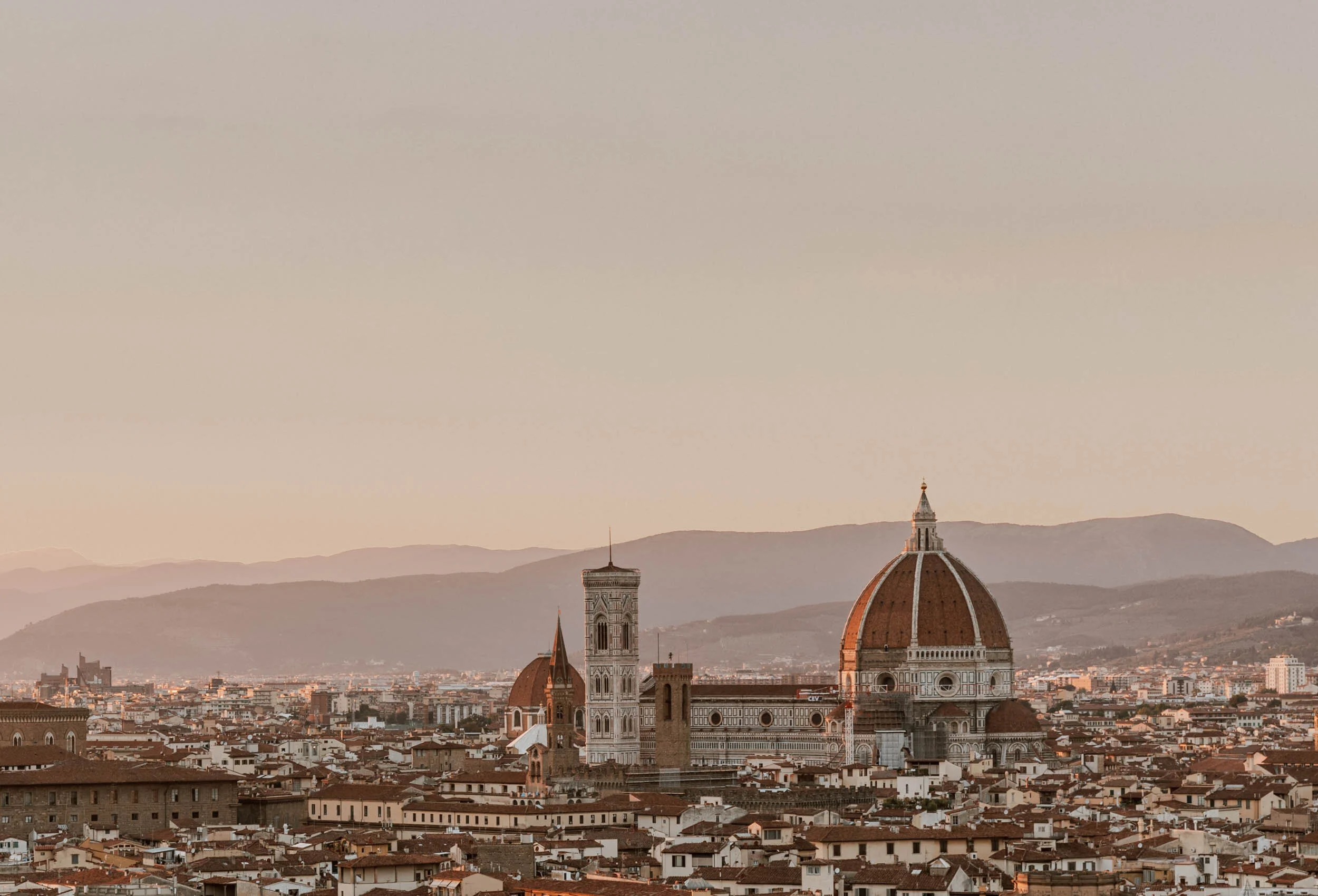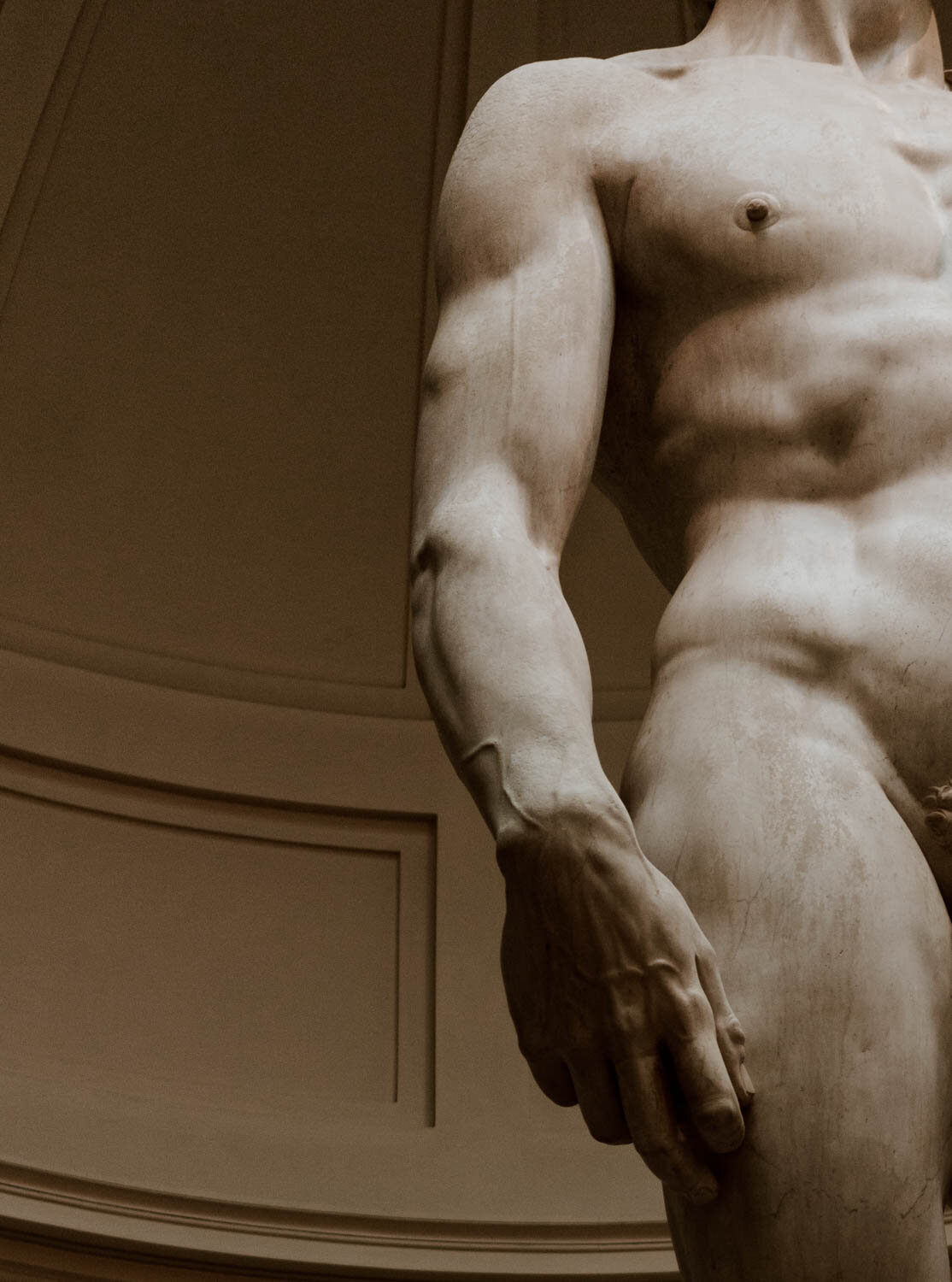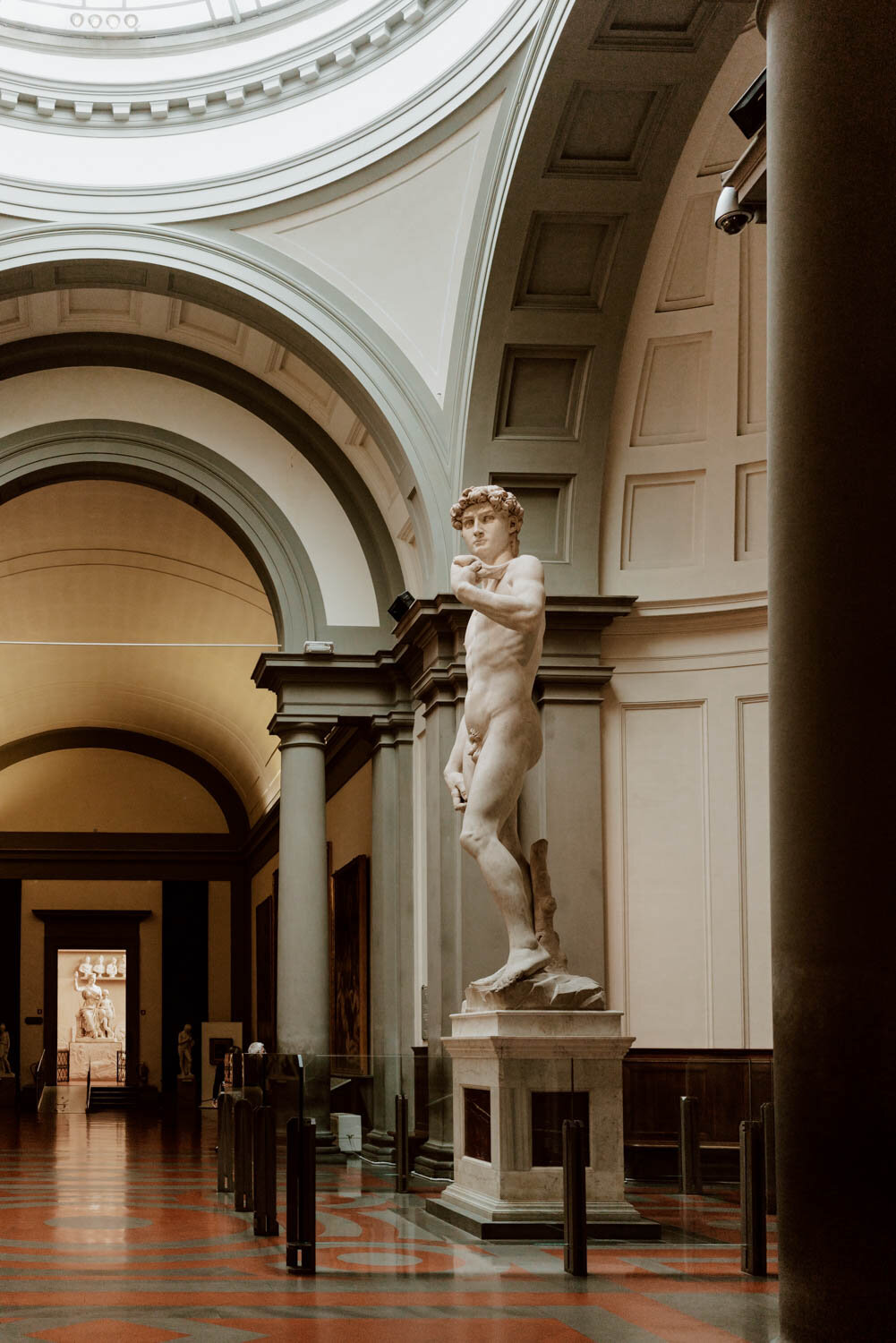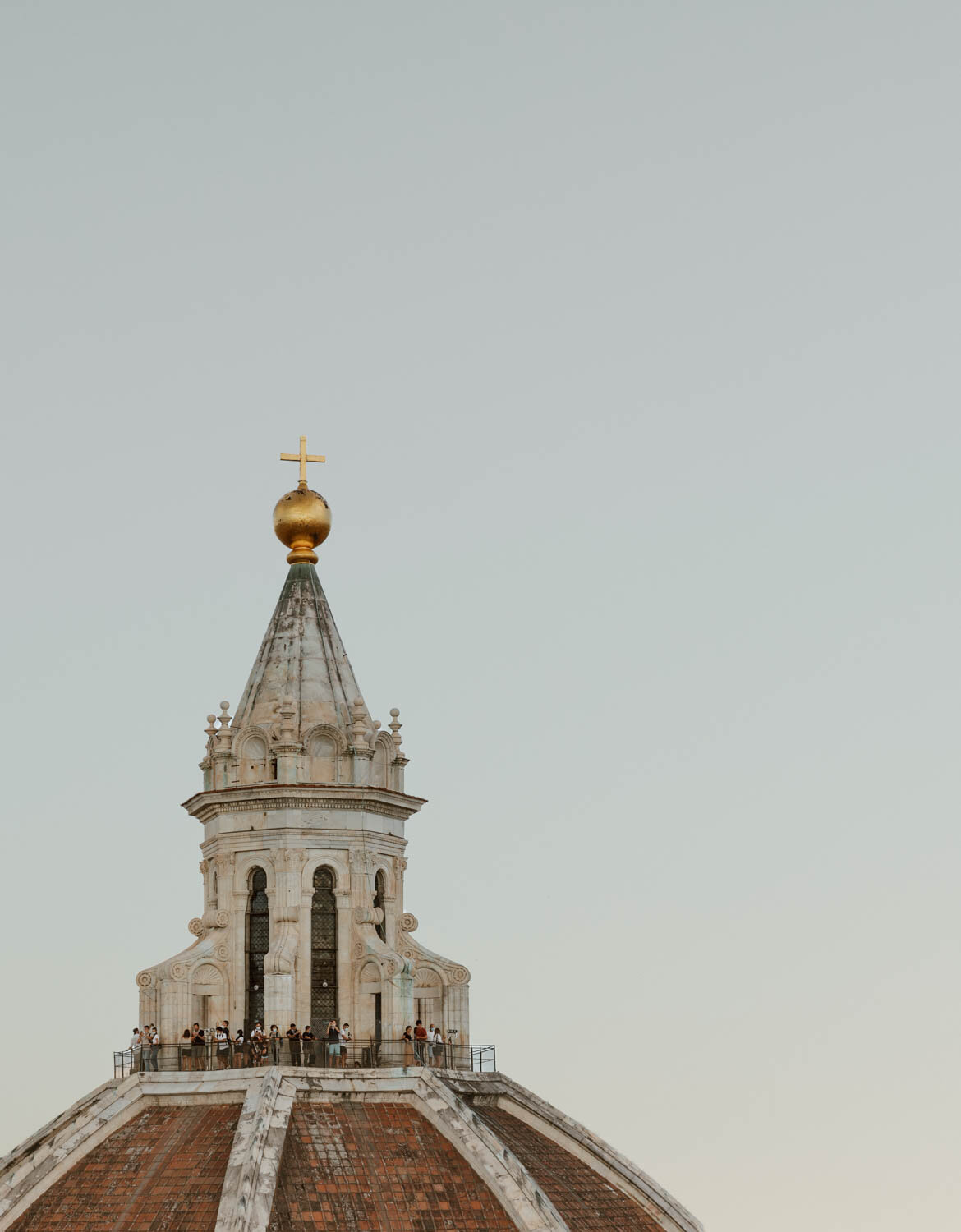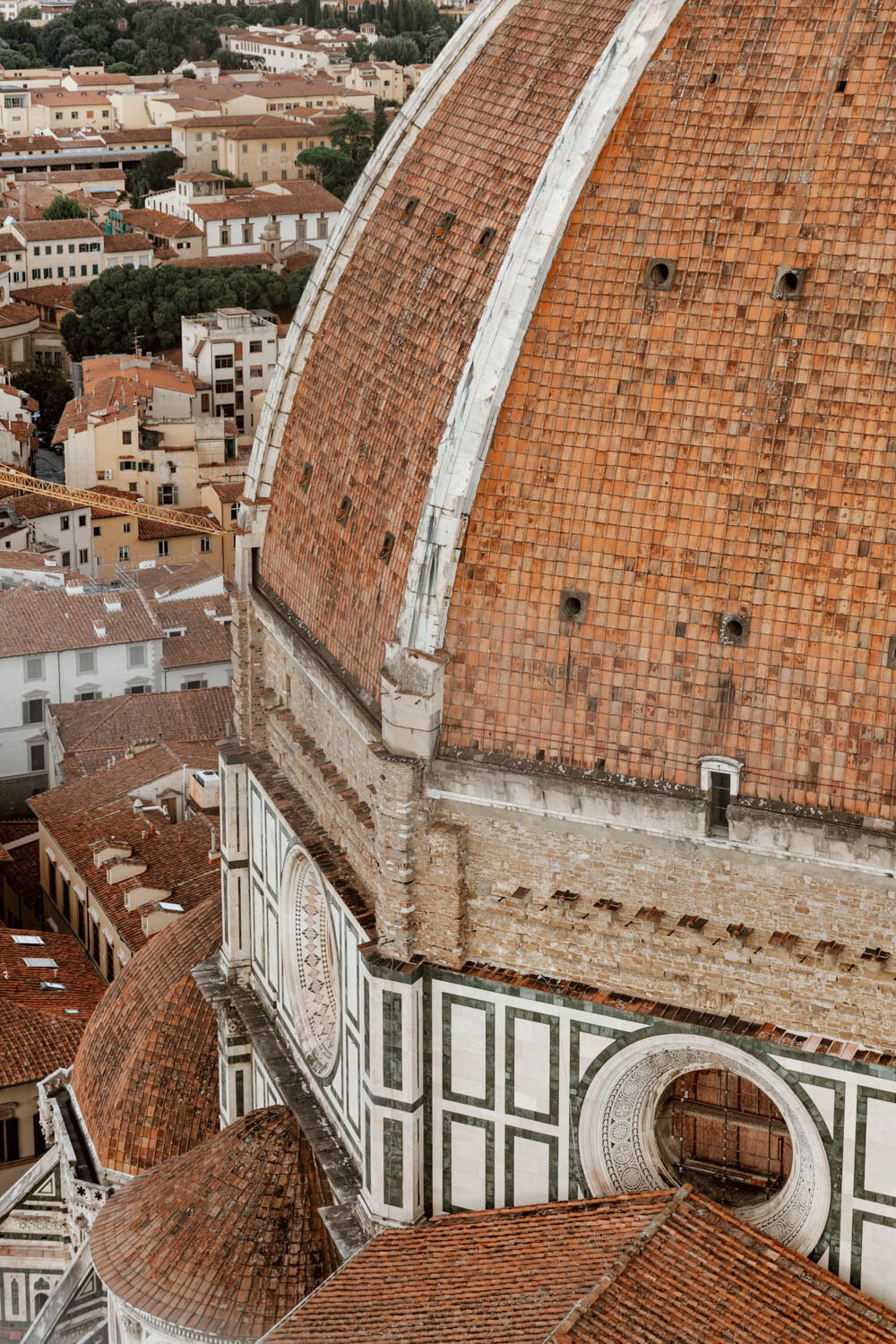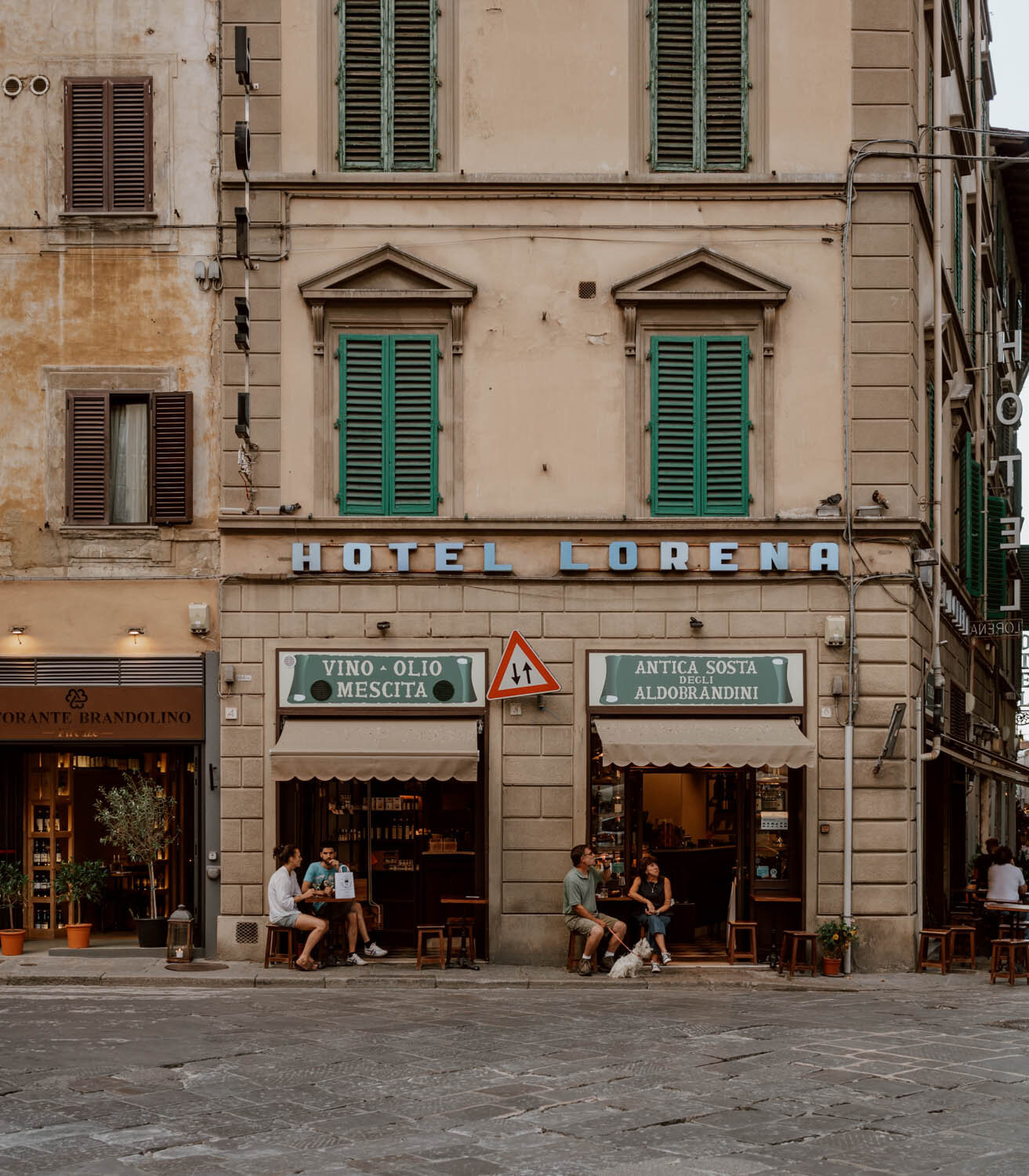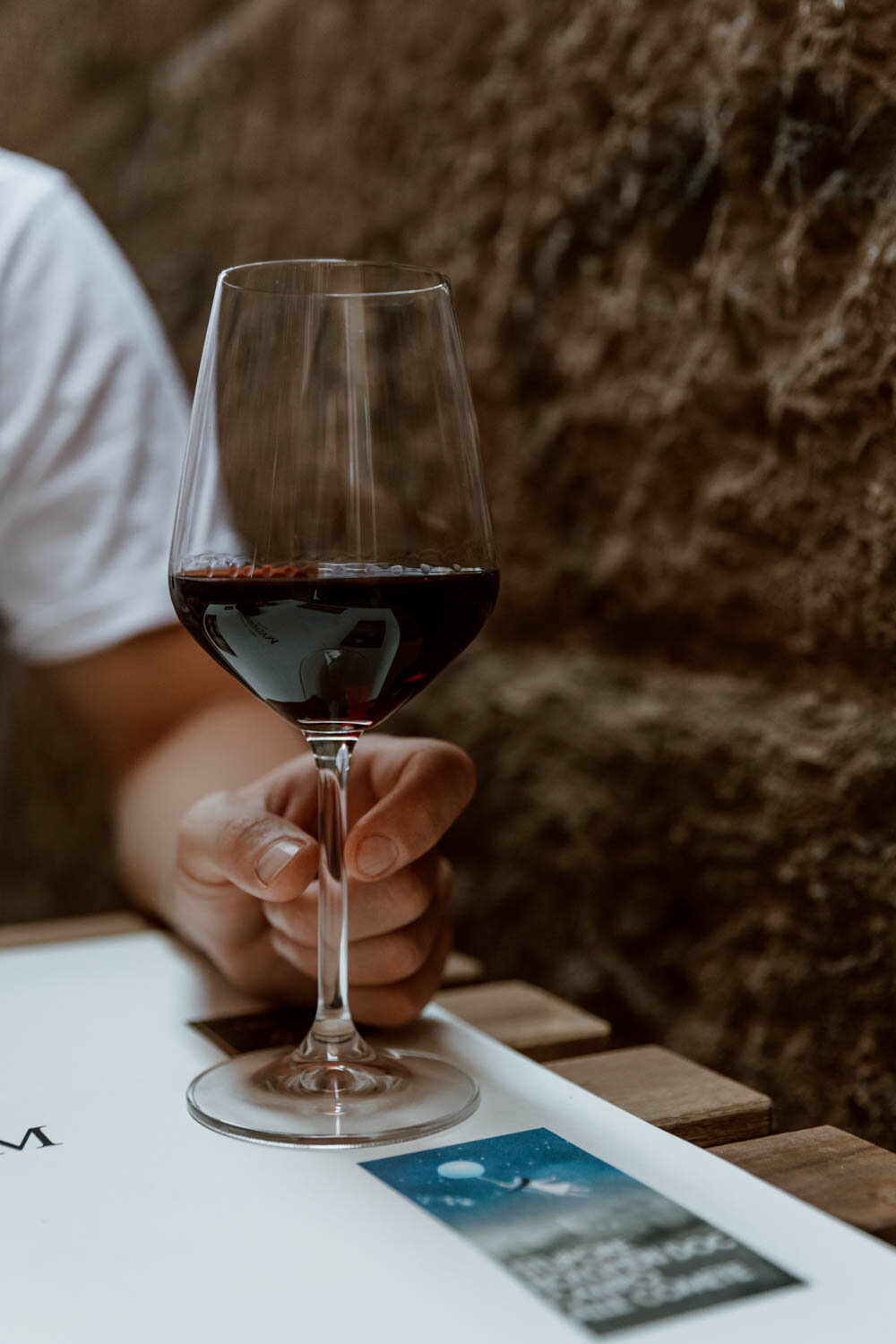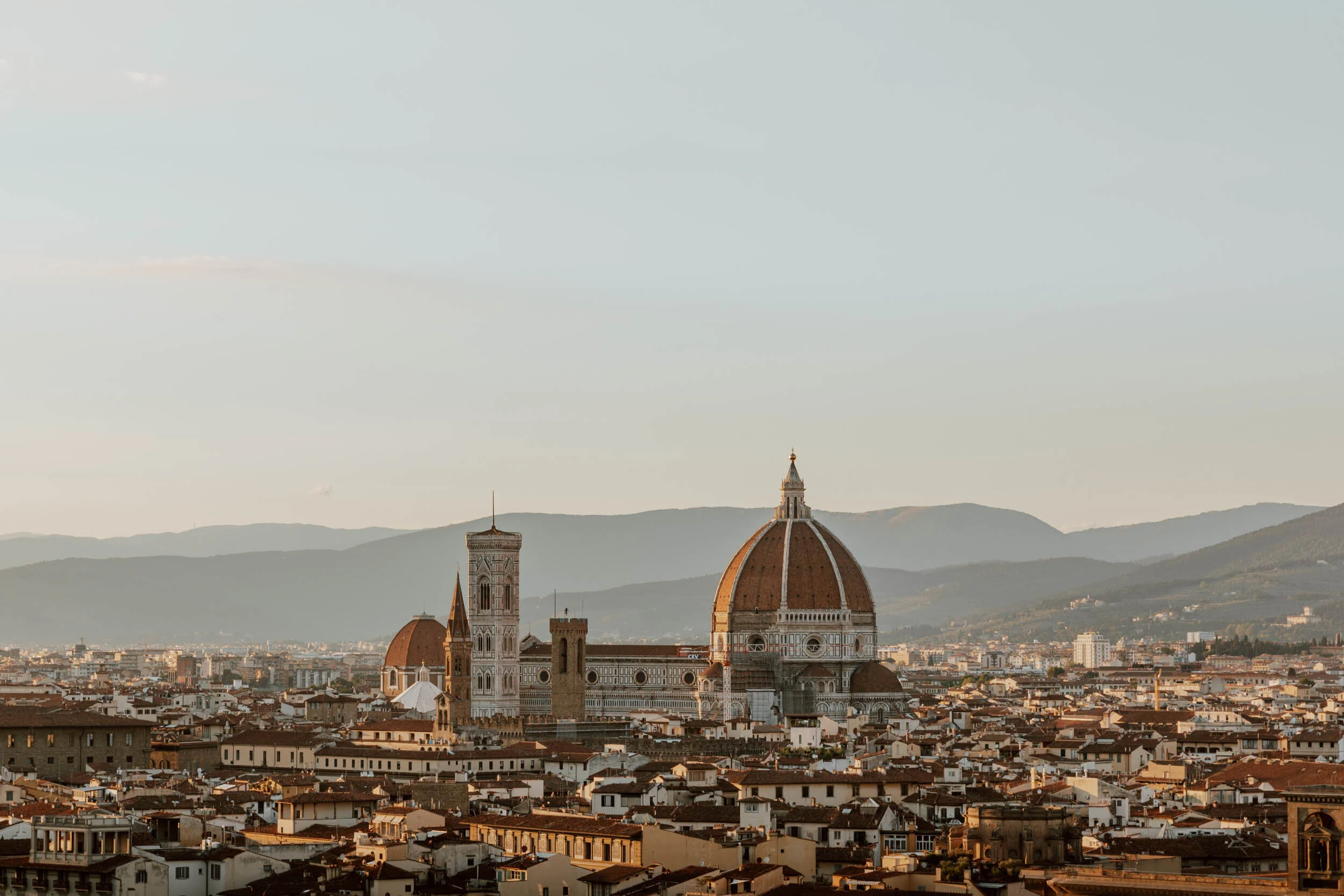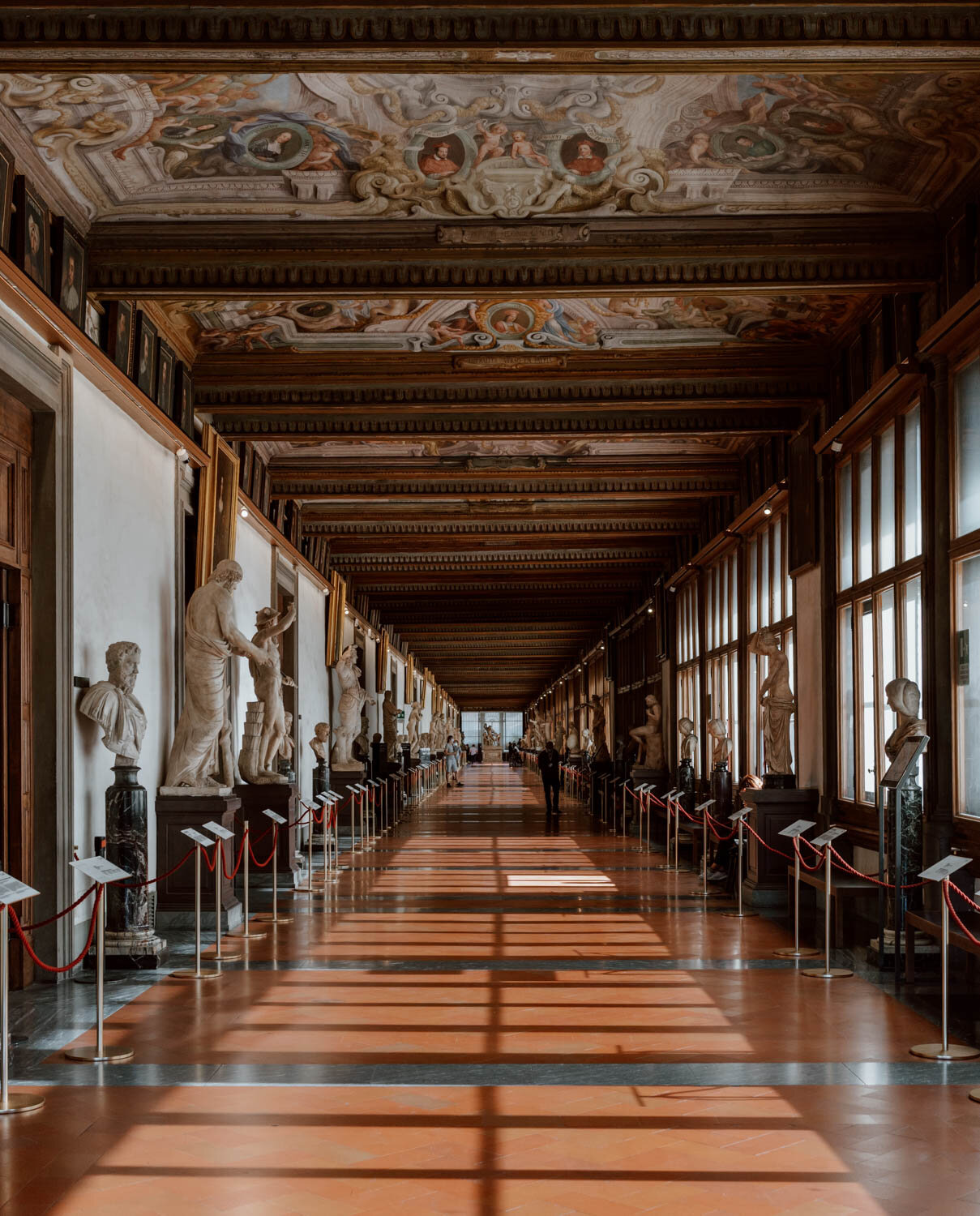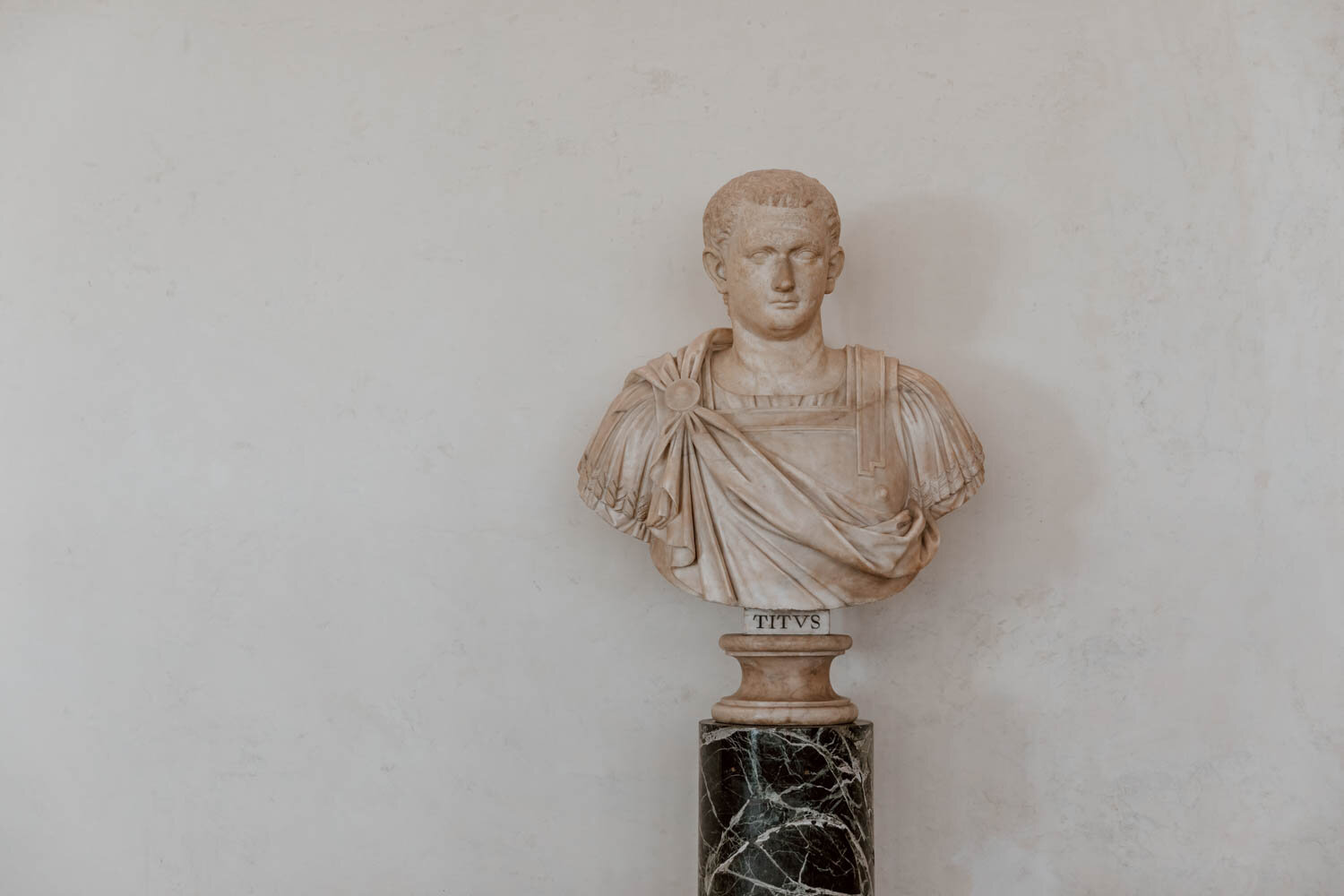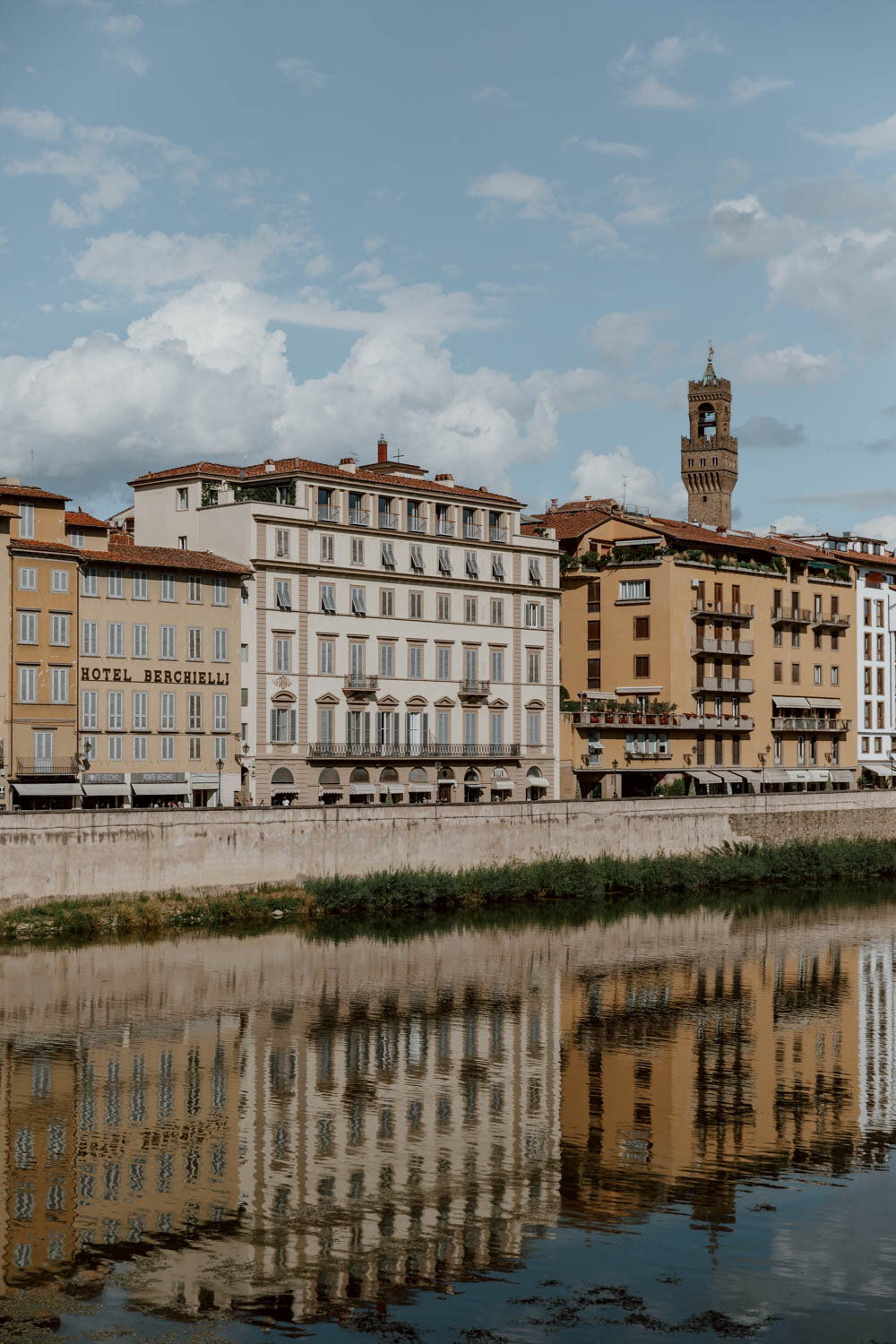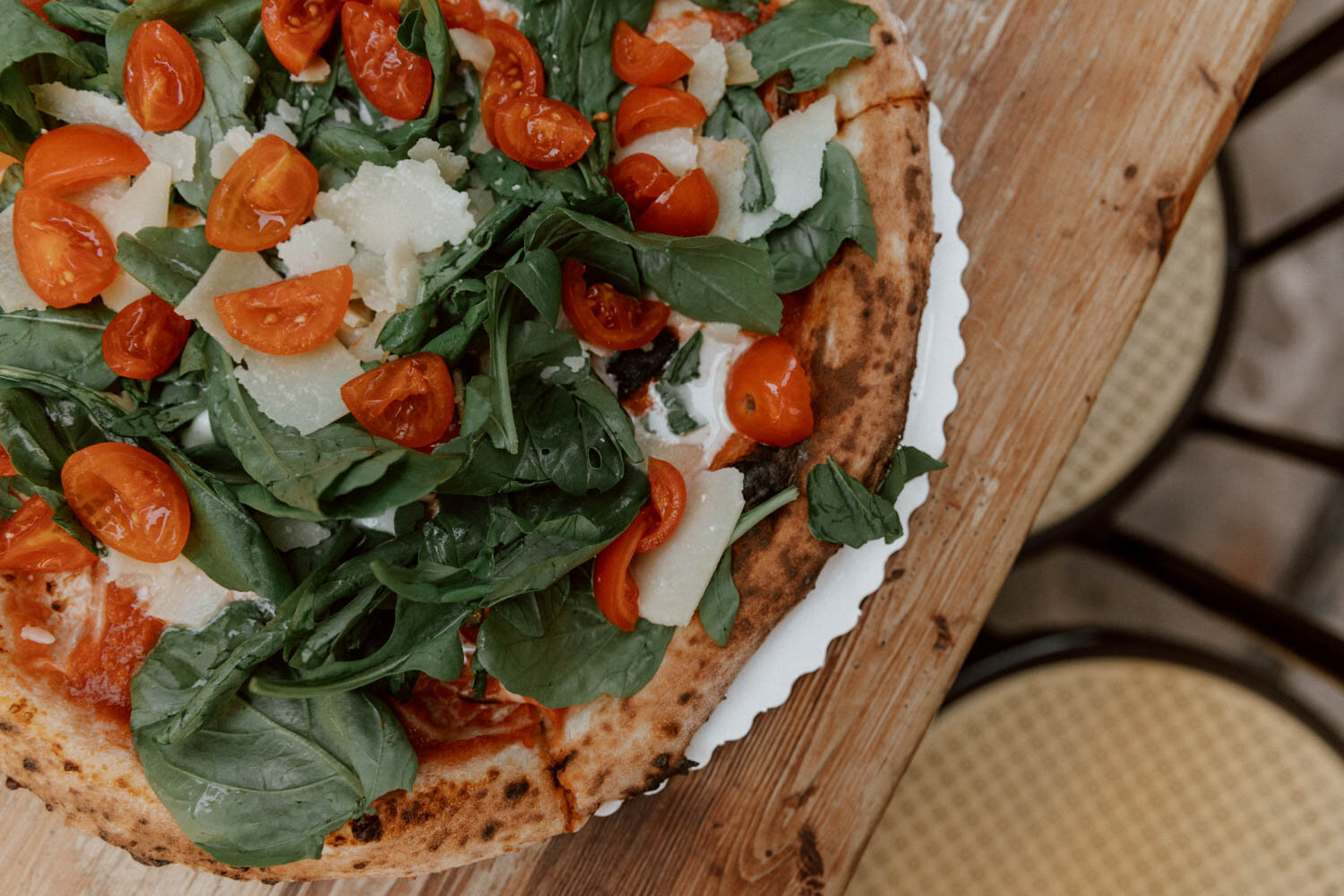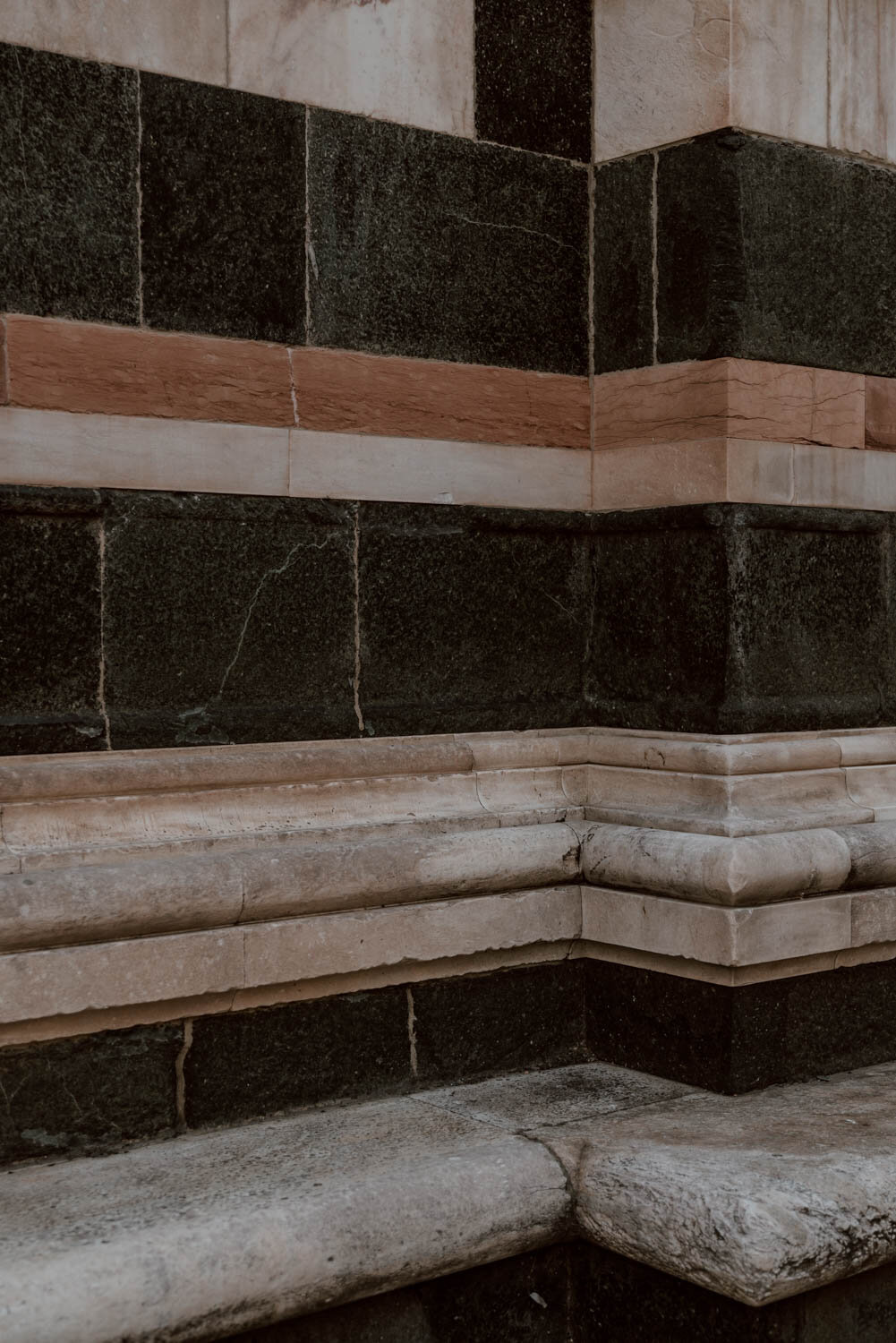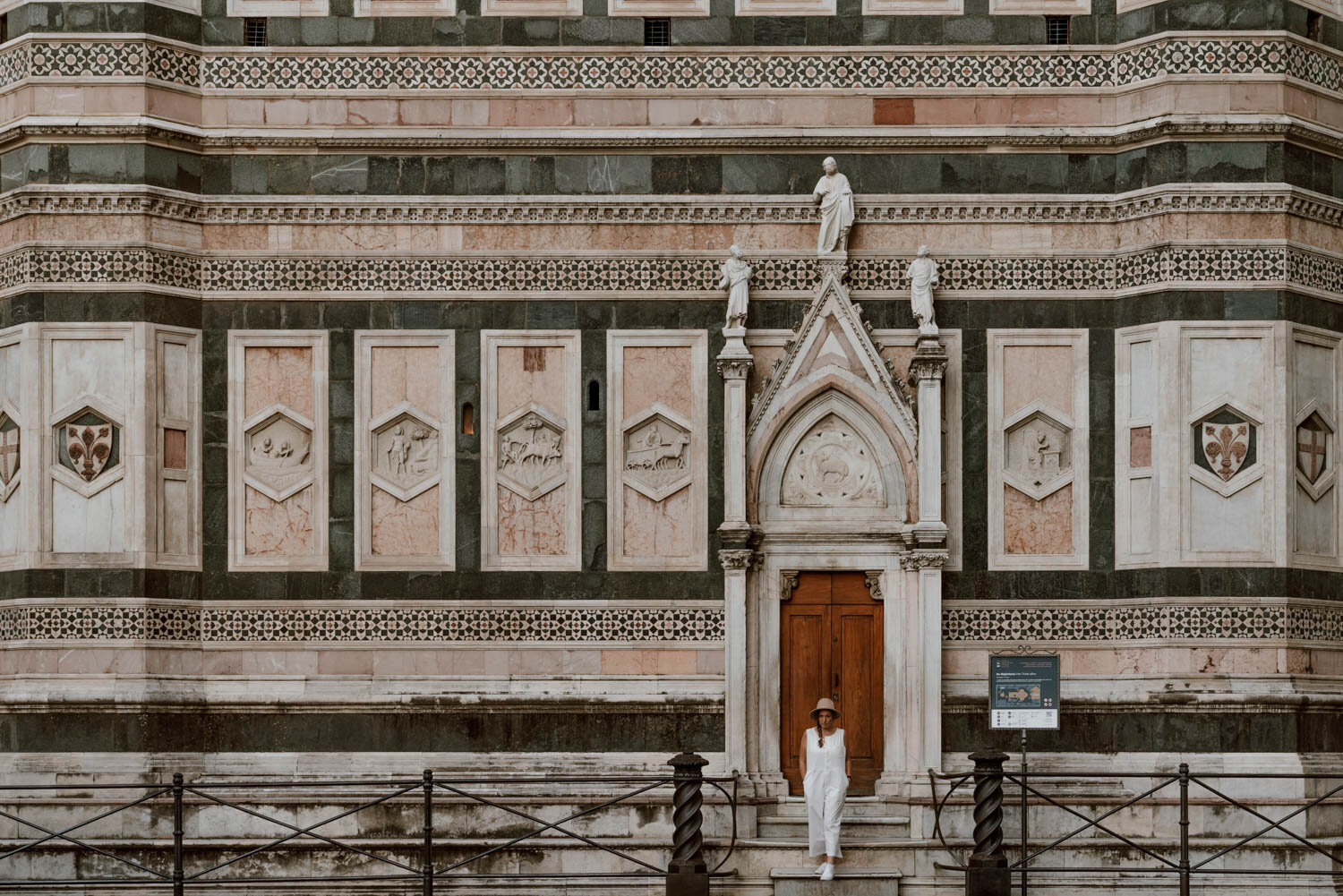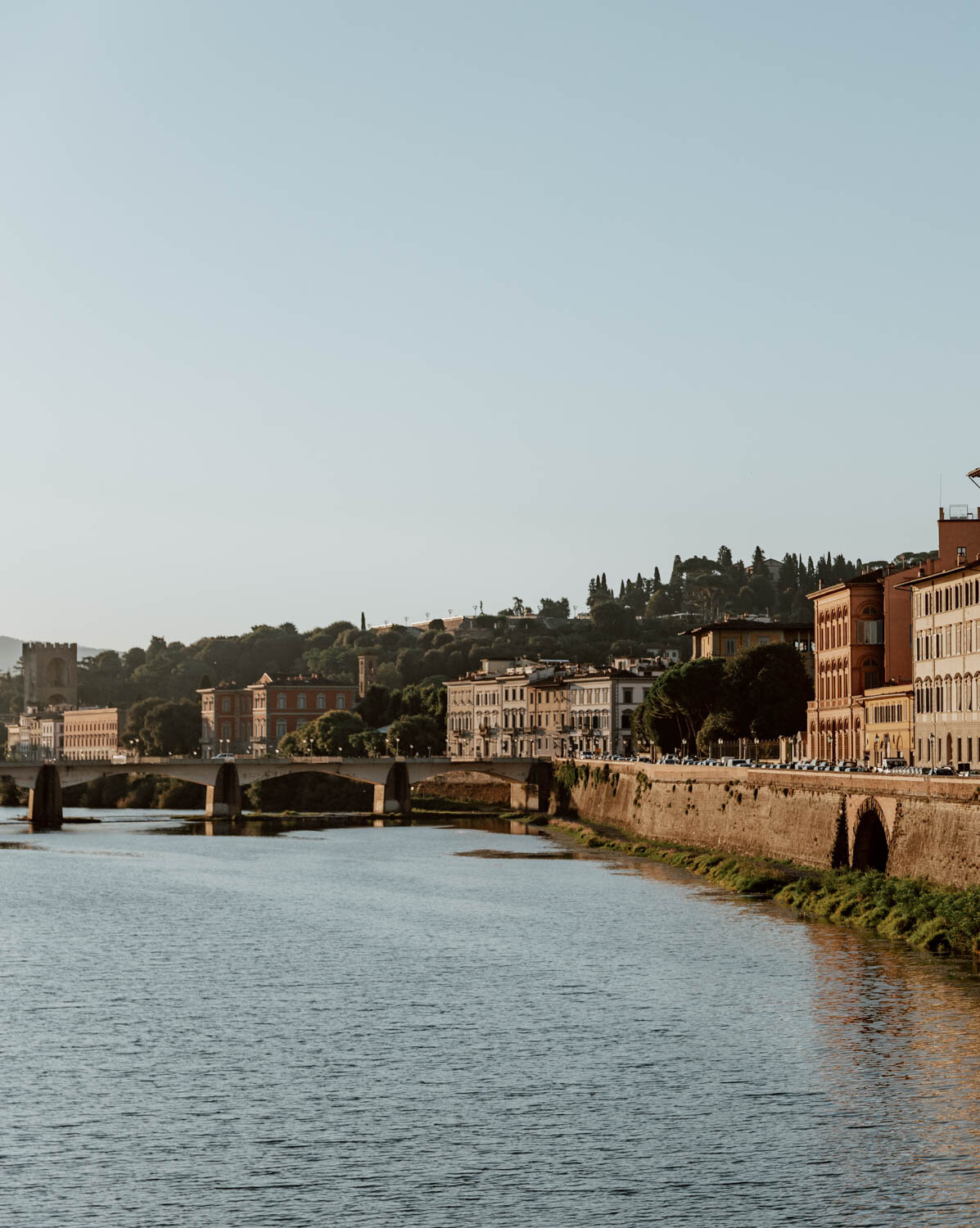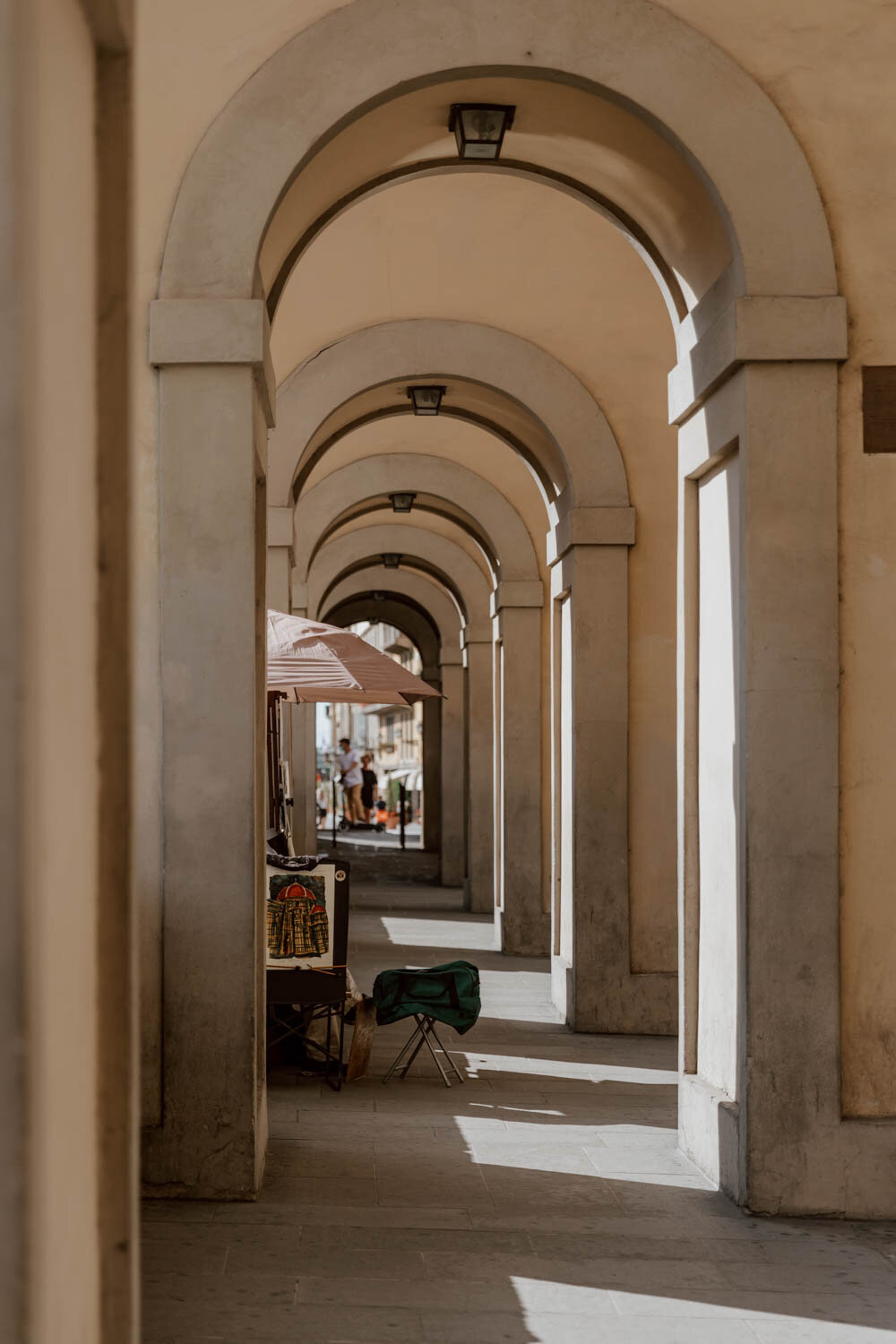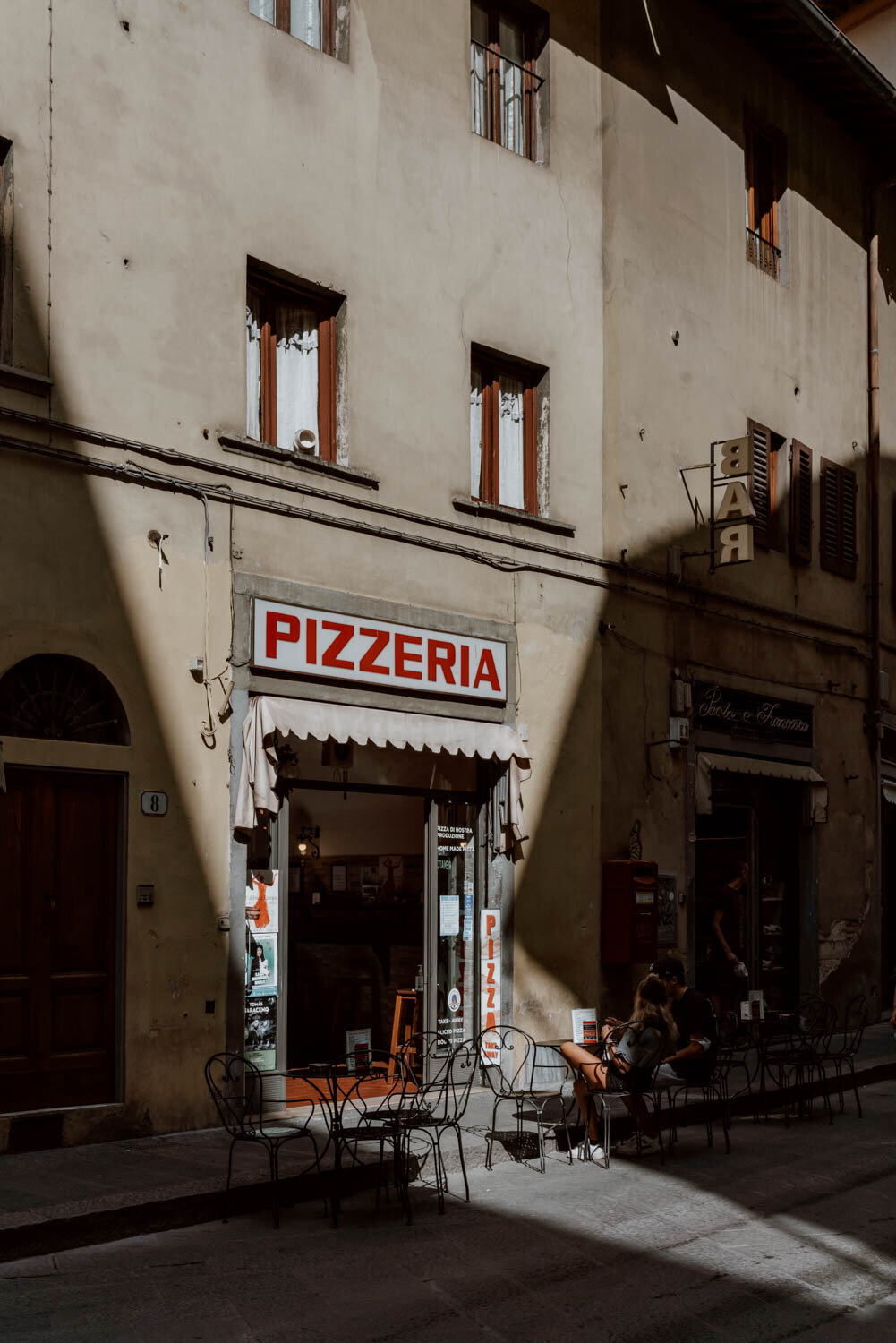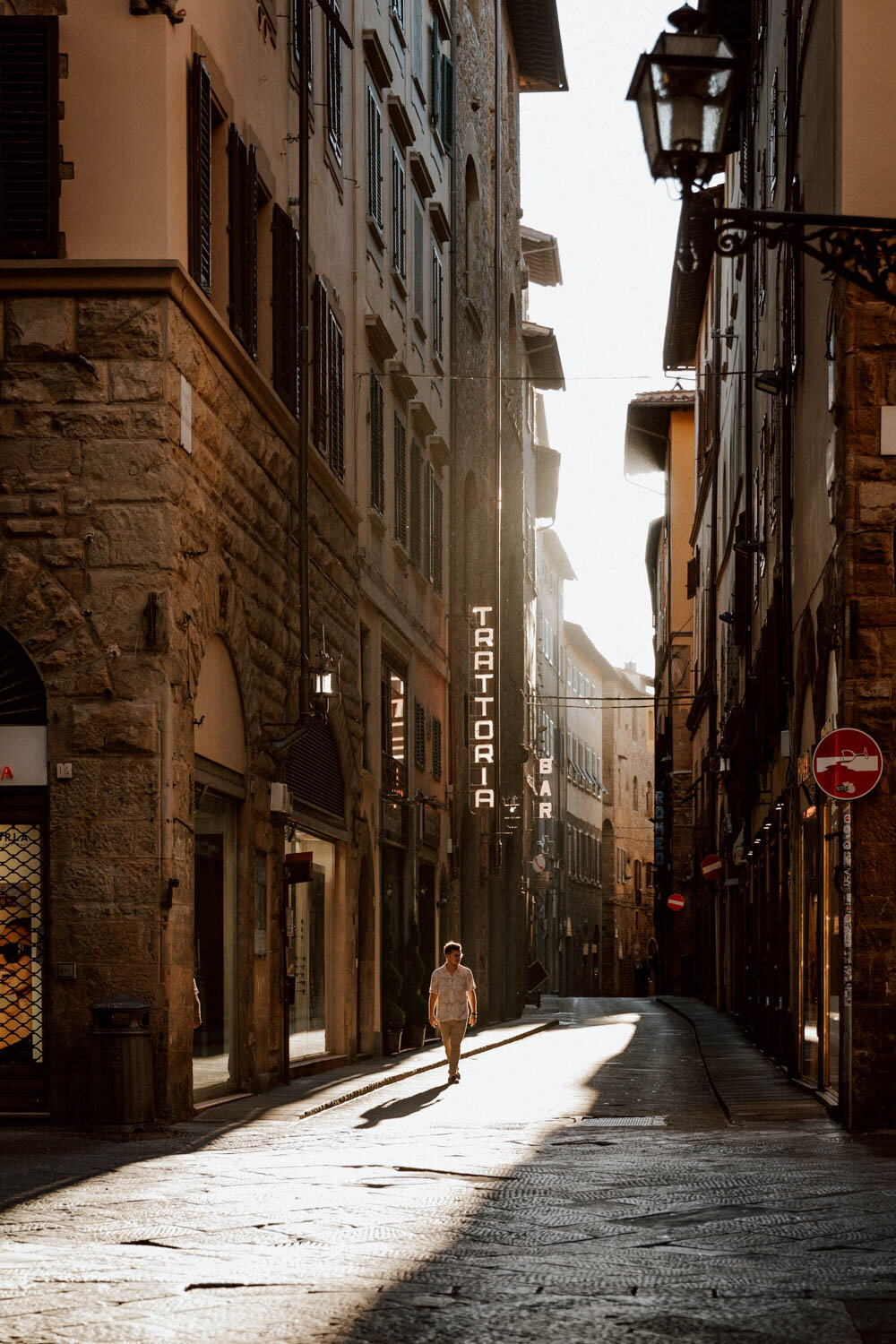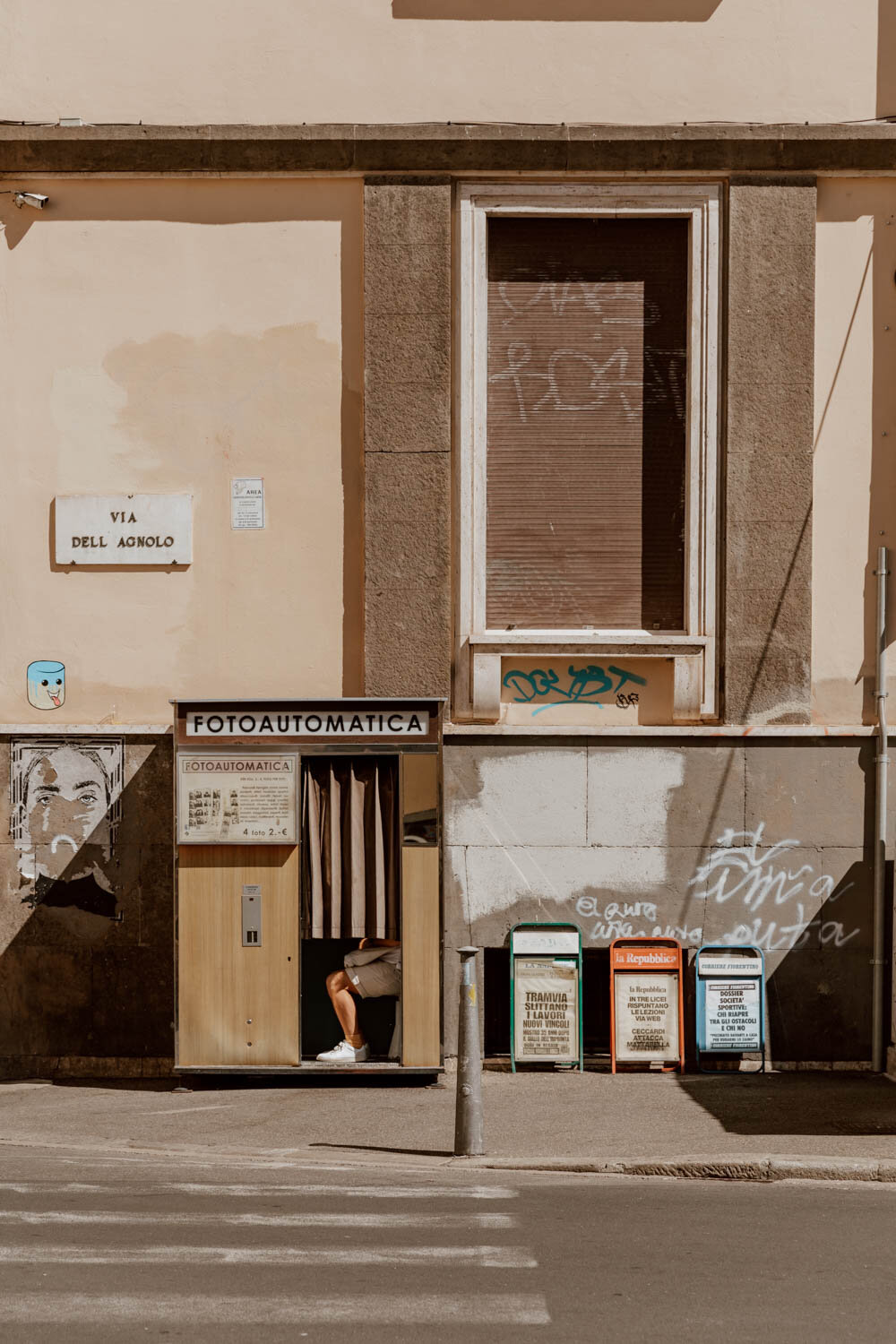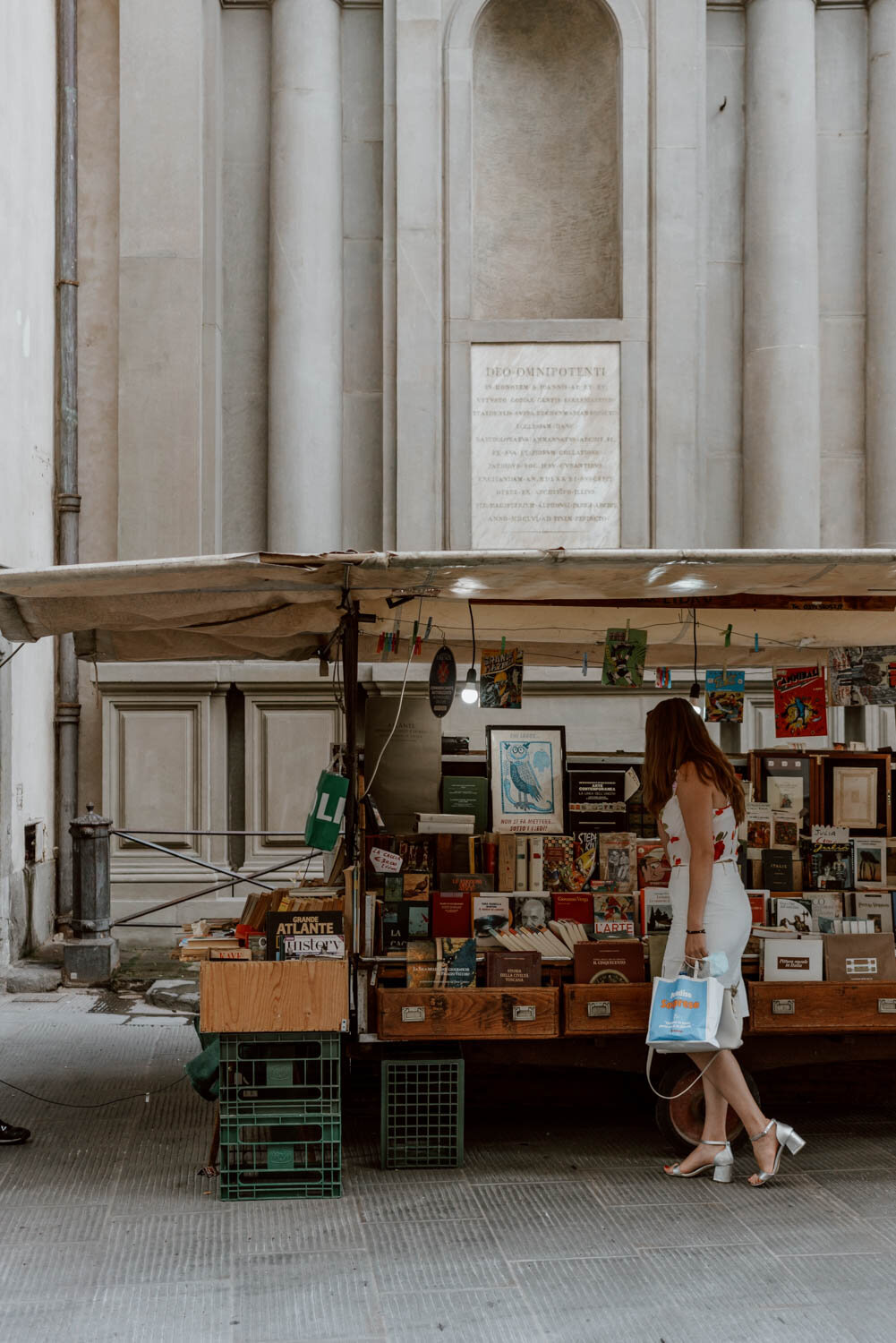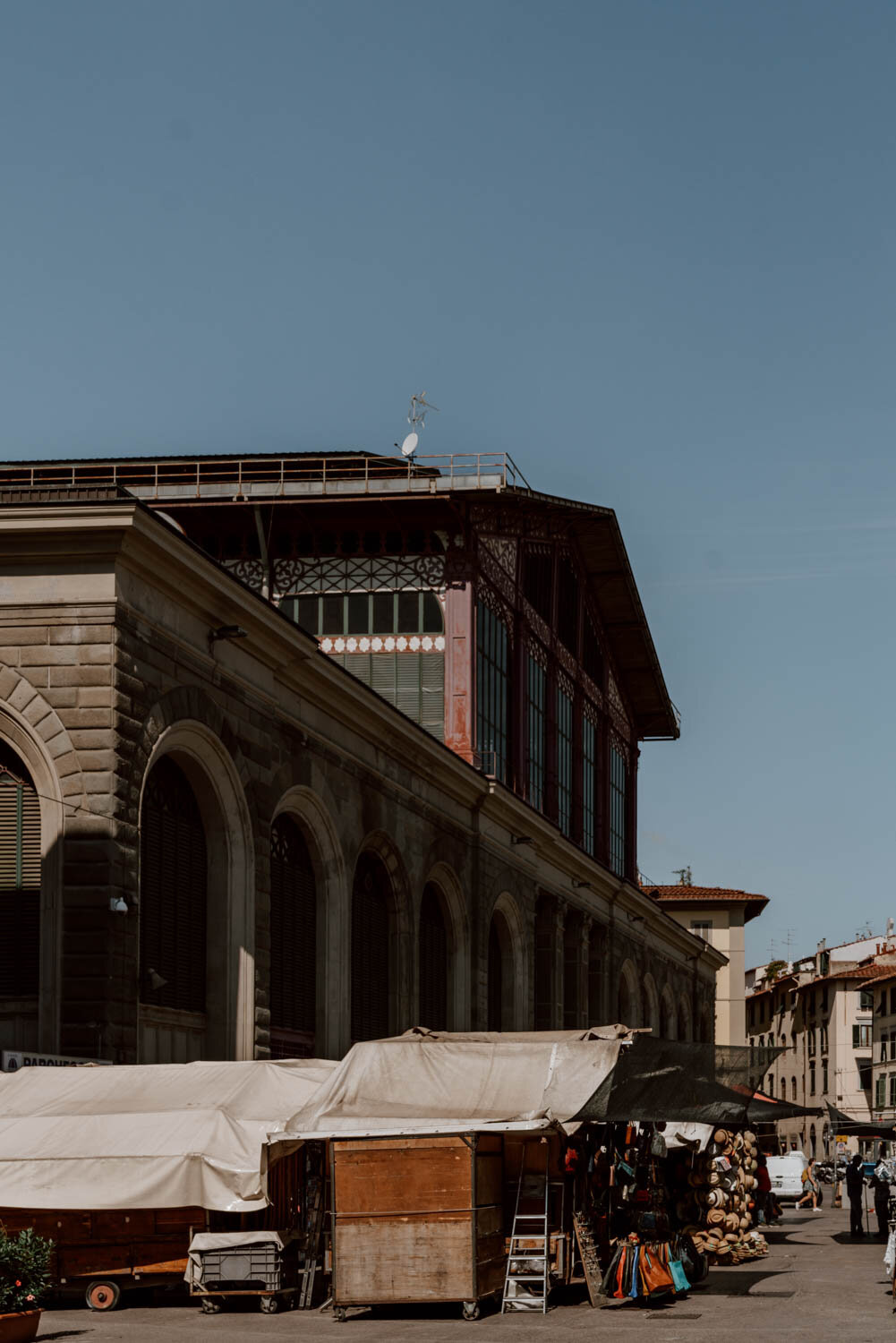With countless museums, historical sights, viewpoints and beautiful streets to get lost in, discovering the best things to do in Florence can be a little overwhelming. So, after having spent a glorious sunny seven days in the city, we’ve curated our absolute favourites into this guide.
There are two chapters to our lives: the time before our visit to Florence, and everything that will follow.
This northern Italian city does not lack in plaudits or fame, but travel is sometimes about condensing the home of grand political dynasties, a cast of visionaries, and the architects of a golden age in humanity, into something personal to hold on to and carry with you.
Florence will forever be the place that taught us more about how to approach and appreciate art than anywhere else in our three decades of existence.
It afforded us the chance to be alone with David, to stare into the eyes of Caravaggio’s Medusa, and to finally fall for the brushstrokes of Botticelli. To understand the presence and importance of key Biblical scenes or characters in art across centuries. To learn to stand back, drink in a scene or lean in to bring out a the detail of a rotting pear, a cut torso, or the sinews of an outstretched limb. To marvel at how a soft, timeless human emotion can be caressed out of hard white stone.
We all hope for travel to be transformative in some way, and it’s impossible to depart this Italian city without a sense of cultural betterment and awe at the works of man.
As the birthplace of the Renaissance, it seems fitting that it continues to invoke personal revolutions from within for those who give it the chance.
The prize of a visit to this city of masterpieces is a new and lasting perspective on the nature of beauty.
Yet, beyond its artistic and architectural treasures, it actually took longer than expected for us to feel charmed by Florence herself.
The banks of the Arno river and the cold medieval pallor of parts of the stone cityscape were not as delicate or captivating as we had expected for the home of Michelangelo’s masterpiece.
That should not make you in any way despondent however; there is more beauty in Florence on a bad day than in dozens of European cities combined. And, when the rising sun shines down a sliver of a street or bathes rooftops dwarfed by the Duomo in pale pinks and violets, your heart will skip a beat.
A little like Venice to the east and Rome to the south, it really isn’t possible to conquer Florence and all it offers in the space of a few days; we had a week there and still have quite a few places on our list!
However, that doesn’t mean you can’t have a fantastic slow travel experience on a short city break or longer stay here. The important thing though is to avoid the ‘planning overwhelm’ that comes with trying to squeeze everything in given that there are such an abundance of things to do in Florence, and focus on doing the things you’ll love.
That’s why we’ve written this article.
Alongside personal favourites and tips, we’ve shared the best things to do in Florence to help you know exactly where to go and what to do on your own visit.
These are 13 wonderful things to do in Florence.
the florence essentials
/ The capital of Tuscany, northern Italy
/ Population of 382,000
/ Called ‘Firenze’ in Italian
/ A global centre of culture, history, fashion, and art
/ Easily accessible by plane + train
13 Wonderful Things to Do in Florence
Fall at David’s Feet
It still feels like a dream.
After an unintentional wrong turn after the ticket check at Galleria dell'Accademia turned out to be very much a right turn, we departed the other group of early-risers into a room; at the end of it, bathed in light, was a boy giant cast in marble perfection.
For an eternal few minutes, we stood alone with Michelangelo’s David.
One of the world’s most famous pieces of art, he was more magnificent in person than we could ever have imagined.
Built from an imperfect piece of marble, it was originally commissioned as one of a series of Biblical statues for Florence’s cathedral. However, its sheer size and weight (over 5 metres high and 5.5 tonnes) meant it would be unfeasible to hoist into place; it was also too impressive to be positioned at such a remove.
A committee (which numbered da Vinci and Botticelli) decided to instead place Michelangelo’s statue of the boy preparing to slay Goliath outside the entrance to Palazzo Vecchio in Piazza della Signoria, with the unveiling in 1504 drawing universal acclaim from Florentines.
A visit to Florence allows the opportunity to slowly devour Michelangelo’s work in detail and from all angles: the intense fearless stare, the impeccable physique, the intricacies of the right hand and the vulnerability of the ankles. Of course, as with the Leaning Tower of Pisa, David attracts a lot of people and lots of people primarily interested in getting a photo with him and moving on.
Our advice is to go early, gaze upon him at your leisure, and bask in proximity to greatness.
The Details
Tickets | It’s €12 per adult, but you have two options: buy your ticket online in advance for a skip-the-queue time slot or turn up an join the queue on the day. The former is the best option if you want to save time and increase the potential to see David with fewer people, but it does attract an additional fee of €4.
Michelangelo’s David is the star attraction at the Galleria dell’Accademia, and every visitor to the Florence plans on seeing him, so do not be surprised if you’re faced with a lengthy queue and wait if you just turn up.
Concessions are €2 (EU citizens aged between 18 and 25) whilst children under 18 enjoy free entry.
Buy your tickets online via the official site here.
Note that if you choose to take a guided tour to visit Michelangelo, the ticket is included in the overall price (this one is a highly-rated option with an art historian).
Where | The Galleria dell'Accademia di Firenze (Google Maps) is located on 58/60 Via Ricasoli on the north bank. It’s a small-ish building and relatively easy miss if there weren’t long queues and the unfortunate scribbles of graffiti on the wall. It’s a bit of a walk to it from the river or other popular sites in the centre; we recommend you factor in 15-minutes for it so you don’t miss your time slot.
The eagle-eyed amongst you may have noted that David and the Accademia Gallery aren’t anywhere near Piazza della Signoria? That’s because he was moved from the public square and nature’s elements in 1873 to be better producted in the museum. A replica was placed in the Piazza in 1910, and remains in place to this day alongside various other statues.
When | Opening hours (September 2020) were 9 am - 6.45 pm (Tues-Sun) and closed on Mondays. There’s no cloakroom, so no large backpacks are permitted.
Tip // You could easily get in, take a photo, spend five minutes looking at him, and then move on elsewhere in Florence; that would seem a bit silly though. Once you’re done with David, we recommend you take a moment to at least visit the neighbouring Gipsoteca (‘Hall of Models’)room, which hosts a captivating array of piled up plaster casts and marble statues by Lorenzo Bartolini, and then loop back round to appreciate him again.
Keep Reading // A Moment With Michelangelo’s David
Climb Into Brunelleschi’s Dome
As impressive as the entire Duomo Complex is (more on that later), there is little doubt in visitors’, historians’, art aficionados’ and indeed Florentines’ minds that without Brunelleschi’s Dome, Florence would not be, well, Florence.
At 45m across, and beginning 54m above the ground, the magnificent cupola was to be the largest dome ever constructed in the 15th century. However, the desire to avoid external arches and gothic design (this was to be a Renaissance masterpiece after all) meant that - perhaps somewhat embarrassingly - nobody knew quite how to build it.
Step forward Filippo Brunelleschi.
Following a competition open to all members of the public, and attracting the crème de la crème of the region’s architects, it came as somewhat of a surprise to all when the commission was handed to this relatively unknown genius (a goldsmith, not an architect) with a secret plan.
His giant cupola dominates the skyline from all vantage points and casts a looming shadow across much of the old town; to spend time in Florence without getting a first-hand look at the work of Sienna’s architectural genius would be criminal.
Yet whilst many satisfy themselves with viewpoints and walkarounds, for a truly immersive experience of the Brunelleschi’s work, one needs to enter the cathedral and climb the narrow 463 steps toward the heavens.
It’s hard going in the heat, and not a great idea if you’re fairly unfit, claustrophobic, or suffer from vertigo or reduced mobility, but the 360˚open-air views out over the orange rooftops of Firenze and the Tuscan countryside beyond are nothing short of outstanding.
The Details
Tickets | Tickets should be bought in advance from the official website. The prices are €20, or €10 for children between 7 and 14. It is incredibly important to note that the popularity of the Dome cannot be overestimated, and even in the winter we’ve heard of tickets booking out several days in advance. We’d recommend purchasing your tickets as soon as you know your dates to avoid disappointment.
Top Tip // Although it is possible to head up the Dome all day, we would highly recommend booking a time slot around the golden hour (from around an hour before sunset). The view is wonderful irrespective, but watching everything glow burnt orange under the setting sun is simply magical. Also, take time to appreciate your unique perspective and proximity to Vasari’s quite terrifying ‘Last Judgement’ on the way down.
Keep Reading // An Essential Guide to Visiting Florence Cathedral and the Duomo Complex
Drink Local Wines
A trip to Florence, as with most of Italy’s great cities, involves culture, galleries, and a ridiculous number of churches. However, that doesn’t mean your itinerary or focus has to be exclusively on cerebral or historical pursuits.
Thankfully, drinking cartloads of wine is not only as essential, but you can pass it off as a cultural activity in and of itself!
The rolling Tuscan hills form a productive, protective, and photogenic barrier around Florence, which is the capital city of the region. If you have longer in Tuscany (or were already planning a Tuscan road trip) you can head out to them on a day trip or tour; if not, then the countless enotecas (wine bars) of Florence will brings the fruits and famous wines of the region straight to you.
The key grape in Tuscany is Sangiovese, with medium and full-bodied reds most celebrated and common: you’ll recognise classic apellations like Chianti, Vino Nobile di Montepulciano, and Brunello di Montalcino. There are however a range of whites to get your lips around too.
You’ll find these on every menu, but the best places to understand the depth and breadth of production in this region is to head to one of the many enotecas dotted around the city. With bottles from producers you won’t find outside of Tuscany, it’s a pleasure to pop into one of these for an affordable glass or two alongside a board of salty snacks or cheeses. Some are very relaxed and unpretentious whilst some are a little fancier and urbane. Notable Florentine enotecas includes Le Barrique, Enoteca Pitti Gola e Cantina, and Vineria Sonora. You can go pot luck based on price, type, or names, but the staff are incredibly knowledgeable and, provided they’re not rushed off their feet, happy to recommend something local to your tastes.
Some enotecas are more tourist-focussed than others and offer tasting menus, deals, or classes.
Two personal favourites for us in Oltr’Arno were Enoteca Obsequium (Google Maps) and Fiaschetteria Fantappié (Google Maps) - the former is a more traveller and tourist-friendly wine bar with fluent English spoken, whilst the latter is more of a small local’s haunt and run by a really lovely guy. If you feel like having something even more unique, then head for a ‘beer wine’ at Fermento Food & Beer - it’s strong and got a very particular taste, but this little specialist beer place is one of the only places to get it.
For any oenophiles looking to learn more about Tuscan wine, then it’s a great idea to do a specific wine-tasting experience or day-trip to the vineyards.
We’ve included a few below which are highly rated:
Chianti afternoon Wine Tour |With a wine-expert guide, this tour takes you through the Tuscan countryside for two tastings and to learn winemaker’s secrets. Find out more here.
This small-soup experience is a good alternative option too, with fantastic reviews across the board.
Tuscany Wine Tour from Florence | Similar to the above, but specifically aimed at ‘independent travellers aged 18-35’. This day trip includes tastings at two wineries, time in San Gimignano, and an English-speaking guide. Find out more here.
A Sunset From Piazzale Michelangelo
This was the place and the moment which made us fall hard for Florence itself.
Slightly tipsy from a few stiff Spritzes, we ambled up the steep stairways from Piazza Giuseppe Poggi in the early evening toward Piazza Michelangelo. One of several testaments to the artist, this also houses the city’s second replica of David.
Here however, the masses turn their back on him.
The four bridges reach out over a Arno flowing gold. The Duomo and Palazzo Vecchio’s Arnolfo Tower point to the heavens, gracefully imposing themsevles over terracotta rooftops and the cityscape. In the background, the Tuscan hills turn from wine to shadow as the sun bids its final salutation.
For us, it’s the best view in Florence and of Florence.
Mark Twain visited the city four times in the 19th and early 20th century, and wrote the following; we suspect it was inspired by this very view, and he puts it better than we could ever hope to:
“This is the fairest picture on our planet, the most enchanting to look upon, the most satisfying to the eye and the spirit. To see the sun sink down, drowned on his pink and purple and golden floods, and overwhelm Florence with tides of color that make all the sharp lines dim and faint and turn the solid city to a city of dreams, is a sight to stir the coldest nature, and make a sympathetic one drunk with ecstasy.”
The Details
Where | Find it here on Google Maps
How to Get There | The quickest way to access Piazzale Michelangelo is via steep stairs from Piazza Giuseppe Poggi in Oltr’Arno (across the river from Florence’s main attractions). Do note that this is quite a hard slog even during the cooler hours of the day. You can also follow the road up from Porta San Miniato (Google Maps). Alternatively, if you’re in a bit of a rush or not in the best of fitness, you can take bus number 12 from Boboli Gardens, or 13 from Ponte Niccolò.
This isn’t a hidden gem, and will draw large crowds of locals and travellers each evening, especially on a balmy summer’s one. Friends bring drinks, lovers bring romance, and buskers bring music. There are a few people selling snacks and souvenirs too.
If you want to grab a good spot on the stairs for yourself or your photography, then head up a little earlier than the others and settle in.
Tip // After the sun sets, you can walk back down Via del Monte all Croci to the San Niccolò neighbourhood for a drink or meal; this spot where three streets intersect (Google Maps) has a few decent options. We ate at Osteria Antica Mescita San Niccolò with low expectations but it was damn good.
Visit the Uffizi Gallery
A morning or afternoon spent at one of Italy’s - and therefore the world’s - greatest galleries needs to be on everyone’s list.
Based within the imposing former administrative and legal offices of Florence (hence the name ‘Uffizi’) the gallery is home to an immeasurable number of Renaissance masterpiece paintings and ancient Roman statues.
Across the two floors you’ll find famous works of Botticelli, Michelangelo, da Vinci, Raffaello and Caravaggio (Andrew’s favourite), set within an environment which is far from the modernist ‘white cube’.
We spent three hours there one morning, but could easily have doubled it and still only scratched the surface. However, what a joy it is to get lost here and simply let yourself be drawn to a certain work or stumble upon an unexpected masterpiece in an empty corner.
The essentials
Where | The Uffuzi building is on the north bank of the Arno, close to Piazza della Signoria. Find the entrance here on Google Maps, which is also home to the ticket collection kiosk and caricaturists outside beneath the grey pillars and statues.
Cost | Entry is €20 per person if bought on the day, however advance tickets, bought for a specific date and time, attract an additional charge of €4. You can purchase advance tickets here (you will be provide with a mobile voucher which will need to be exchanged for a paper ticket at a separate office outside the Uffizi).
Do note that as many people choose to buy their tickets in advance (like we did - and we highly recommend that you do so too), there can be incredibly long queues at the ticket office. Should you wish to avoid these, you can buy tickets here and pick up your paper entry immediately thus saving time.
We do appreciate that so the Uffizi may feel like too big a stretch for some budgets. However, we’d implore you to do your best to visit (the Caravaggio and Botticelli works are worth the price of entry alone, as is the Gaddi Torso).
Tip // This highly-rated 1.5 hour small group tour of the Uffizi includes skip-the-line tickets and an expert guide. You are free to remain in the museum once the tour has concluded.
//
The Medicis & Macchiaveli
The story and rise of Florence as the cradle of the Renaissance is intertwined with the Medici family dynasty. In pre-unification Italy, they ruled Florence and Tuscany as effective monarchs for about three centuries. Beyond the political, mitilary, and diplomatic power plays, their patronage of the artists, humanities, scientific thought is viewed as the key factor in the flourishing - the rebirth - of a post-Medieval Europe. Without their influence, names such as Michelangelo, Raphael, Donatello, and Leonardo da Vinci may well never have become so important as to be used for the Teenage Mutant Ninja Turtles.
Alongside their personal collection playing a key role in the start of the Uffizi, the family birthed four Popes, many of Europe’s royal families can be traced back to them in some way, and can be credited with funding the invention of the piano.
Niccolo Macchiaveli, born in Florence, had a chequered, ill-fated relationship with the family, but his famous work on power - The Prince - was created within the political environment of the Medicis’ Florence and was actually dedicated to one of the family (though they put him in prison).
//
Explore Oltr’Arno
The north bank of the Arno is home to the most famous things to do in Florence, its fashion houses, and its galleries; many of you will be based there and everyone will spend a lot of time there.
However, across the river in Oltr’Arno, the scene is much more low-key with a younger more intimate, bohemian vibe.
Literally meaning ‘beyond the Arno’, this neighbourhood attracts visitors due to places like Pitti Palace, the Boboli Gardens, and Porta Romana but it was the part of the city which we most enjoyed hanging out in and stumbling across some hidden gems. Small artisan shops and ateliers, little family run restaurants, and young locals enjoying wine and music.
During the day in Piazza Santo Spirito (Google Maps), there’s a little daily market and restaurants and cafes sprawling out under the afternoon sun, whilst in the evening it’s got a lively, social atmosphere with students gathering on the steps outside Basilica di Santo Spirito. This church’s plain exterior belies its sumptuous interior, which was designed by Brunelleschi and includes early work by Michelangelo, so do pop your head inside if passing by. Entry is free but photography not permitted and, as ever, dress appropriately.
Get lost and follow you nose in the area, but a few of our favourites haunts to make a beeline toward are:
SBrino | When in Italy, we usually ask our Instagram followers for gelato recommendations. Naturally, for Florence, we got quite a few! One woman in particular was however so adamant that S.Forno was the only gelateria in Italy she would pay to be transported back to, that we simply had to make sure we sampled it for ourselves.
Her praise was not misplaced.
S.Forno Panificio | Pop your head into the bakery next door at some point. It’s part of the trio of business on this side of the city run by the team behind Il Santo Bevitore, a nearby restaurant which is very highly regarded (we unfortunately didn’t make it there).
Ristorante Borgo Antico | Lunch in Piazza Santo Spirito is an enjoyable, affordable affair, and the simple pasta dishes we had at Borgo Antico were delicious. We also ate at Osteria Santo Spirito which is a good value and popular option but if you have the truffle gnocchi, make sure you haven’t eaten for three days in advance.
Trattoria Boboli | Continue on from Palazzo Pitti toward the Boboli Gardens and Porta Romana, and you’ll find this restaurant on the left hand side offers well-priced traditional Tuscan fare and a small outdoor terrace at the back.
Piazza della Passera | A quite little nook with good gelato on the corner Dondurmaci, Trattoria 4 Leoni and Osteria Tripperia Il Magazzino for a slightly fancier lunch or dinner, or an evening aperitivo or late night drinks on the tables outside Cafe degli Artigiani or Bulli & Balene.
Via di San Nicolo | We stayed on this street within the San Niccolò neighbourhood, and it’s home to some little boutiques, parfumeries, and curios shops; we adored the charming handcrafted notebook shop found halfway along. Continue along here and you’ll emerge out on a little piazza where three streets intersect, which is a good shout for a drink or food before/after Piazzale Michelagnelo (avoid Bevovino though)
Fort Belvedere | Keep an eye out for temporary art exhibitions at this building, which was the site of Kanye West and Kim Kardashian’s wedding in 2014….
Gustapizza | A very popular hole in the wall option on this side of town with students and visitos, with a short menu of excellent Neoplitan style pizzas for €5-8 served fast. Eat in the hustle and bustle inside, on the handful of tables outside, or do as the locals do take it away in the evening to eat in Piazza Pitti.
They shut at 3 pm and reopen at 7 pm and remember, in Italy, it’s one pizza per person.
If you’re looking to be out until the wee small hours, then The Speakeasy is a good shout, whilst keep an eye out for a leopard spot spraypainted door…
A Stroll in the Boboli Gardens
We strive to do everything we recommend because, well, that’s what travel blog is all about.
Unfortunately, one of the places high on our personal list of things to do in Florence was shut for the entirety of our week in the city; we were gutted.
However, that doesn’t mean we’re not going to let you know about it!
A vast, manicured oasis in the heart of the city, the Boboli Gardens were built for the Medicis in the 16th century. Another tick in Florence’s ‘open-air museum’ credentials due to its statues and fountains, a famous example of the ‘Italian Garden’ style, as well as somewhere to relax a little in the summer heat, it was a designated as a UNESCO World Heritage Site in 2013.
Next time Florence, next time.
The Details
Tickets |Entry is €10 per person, €2 for EU citizens aged 18-26, free for children under 18 and people with disabilities.
Where |It’s just behind the Pitti Palace in Oltr’Arno, but there are various entry gates. Choose from the one at Pitti Square, Porta Romana Square, Belvedere Fortress, or the Via Romana gate
When | Open from 8.30 am to 6.30 pm in summer months, closing at 4.30 pm (November - February) and 5.30 pm (March + October) out of season.
Gasp at The Cathedral & The Duomo Complex
If there’s a single jewel which deserves to be the centrepiece in this festooned, shimmering Renaissance crown of a city, then it is the Duomo di Firenze.
Officially called the Cattedrale di Santa Maria del Fiore (Google Maps), the cathedral and its neighbouring Campanile (Belltower) resplendently rise up from the clustered, narrow streets under a ground surge of pride to shape the Florentine skyline. Fantastically large in scale and scope, the cathedral’s remodelled 19th-century facade of geometric patterns and panels in green, white, and dusty pink marble is ostentatious, intricate, and awe-inspiring. Topped of by Brunelleschi's Dome, one half of ADR ranks this as the most impressive building he’s ever seen in the flesh.
You literally cannot miss these two during your stay in Florence, and we recommend you take some time to slowly circumnavigate the cathedral to drink in the detail and ambition of it all (it’s bloody nigh on impossible to capture in a single photograph).
Piazza del Duomo (Google Maps), the name given to the central square, contains the Cathedral, Giotto’s Campanile, the Baptistry of San Giovanni, Crypt of Santa Reparata and the Opera Museum, offers even the most inquisitive and fastidious tourist hours of artistic, historical, and intellectual entertainment. Collectively it’s referred to as ‘The Duomo Complex’ and, due to big changes in ticket prices and terms introduced in 2020, it’s essential to plan what you’ll visit and buy tickets in advance.
We’ve shared all the key information and context to help you in this dedicated post: Visiting The Duomo Complex | An Essential Guide.
Tip // On social media, you may have seen a very common photo amongst influencers who stay at a rooftop hotel with a stunning Duomo backdrop. If that’s something you’d like to do ‘for the gram’, then this is the place to book. Alternatively, The Four Seasons also has a spectacular backdrop of the Duomo from its rooftop, and the Student Hotel Florence also has a great view.
Criss-cross Ponte Vecchio & The Arno
Before we arrived in Florence, neither of us had actually conceived of it as a river city. That’s probably ignorance on our part, but we didn’t travel there with the impression that the water would define our visitor experience as much as in European metropolises like Paris, Budapest, Porto, and London.
Turns out we were half right.
Though the river Arno splits the city in two, its banksides are not home to pleasant walkways, cafes, or recreation spots in the centre. We’re probably in the minority in this too, but it’s a big part of why we didn’t find Florence as alluring as anticipated in the first few days.
However, you will walk to, from, over and beside the Arno multiple times as you explore the city, and take yourself from the north bank’s wealth and fashionistas to the south bank’s more hipster, artisan vibe.
The main attraction by the river is three-arch Ponte Vecchio (‘old bridge’), a real symbol of the city and the only Florentine bridge to survive World War 2 bombing. Crossing the river at its narrowest point, it feels more like a street than a bridge, lined as it is with a jewellery shops and goldsmiths stacked high and tight on both sides. There’s actually an old line amongst locals to describe any woman wearing jewllerly which is a tad too ostentatious as ‘carrying more gold than the Ponte Vecchio’.
Shops have existed on the bridge since its construction in the 14th century, but for a period of time it was rented exclusively to the ‘Guild of Butchers’… and one can imagine how this would not have made Ponte Vecchio or the Arno a very enticing olfactory experience.
Tip // For the best views of Ponte Vecchio, check out this post: The Best Views of Florence
Visit Via de Neri & Piazza della Signoria
Personally, the aesthetic and palette of Piazza della Signoria (Google Maps) is a little too cold and a little too sober to have us salivating, but it’s a pivotal place in the story of Florence.
The austere structure of Palazzo Vecchio, built between the 13th and 14th century, is the focal point. A historical monument, a medieval fortress, and a Renaissance beauty (internally at least), it’s been the seat and symbol of civic power for more than seven centuries within the city. Indeed, to this day it still acts as a seat of local government, housing both the mayor’s office and Municipal council.
It was also the site of the infamous ‘Bonfire of the Vanities’ where a fanatical Dominican monk persuaded Florentines to burn cloths, art, books, and jewellery - their ‘objects of vanity’ - on a huge pyre before the impending end of the world.
If you choose to pay to go inside, Palazzo Vecchio also has one of the best views of Florence from the 95-metre Torre di Arnolfo (second only in height to Brunelleschi’s Dome), that literally towers over Piazza della Signora below.
Yet for many who visit, it is the contents of the grand square in which it stands - an impressive replica of Michelangelo’s ‘David’, Neptune’s Fountain, the Uffizi Gallery plus many more Renessaince statues and sculptures within the Loggia dei Lanzi - that garners much more interest. These statues are rife with symbology and political meaning, as well as being works of great artists, so it’s worth getting a little more acquainted with them. Cellini’s ‘Perseus with the Head of Medusa’ is a personal standout.
A short stroll from Piazza della Signoria is Via de Neri (Google Maps), a narrow pedestrianised street which is a great shout for breakfast or lunch before/after the Uffizi Gallery and also offers some decent laid back nightlife too. There are a bunch of unfussy restaurants and a growing hipster-establishment scene, and two places to check out in particular are:
Ditta Artigianale | A cool specialty coffee shop that we had high hopes for after lots of people recommended it to us, however we left a little unsure whether it deserved quite as much hype. The coffee and space ticked the boxes, but the atmosphere seemed a little off during our visit (which may have just been a bad day and / or due to the dodgy music playlist). Still, if you want something more like a cold brew or a flat white and a place to hang out for an hour, this is the spot to go to. They also do non-dairy milks.
Base V Juicery | Juices, smoothies, and lots of fresh, healthy food options at this vegggie / vegan place.
We’re vegetarian, but it would be remiss of us in this travel guide not to let you know about two very popular things to do in Florence. The first is All’Antico Vinaio, a sandwich place also on Via de Neri, which see queues out the door and down the street from late morning until mid-afternoon. Everything on the menu sounds like the sort of sandwich Tony Soprano would insist upon, and it’s evolved from a local’s favourite into one of the most popular street food spots in the city. .
The next is the Florentine steak or bistecca alla fiorentina: a big hunk of T-bone (note that it’s usually from a calf), seared on the bloodier side of medium-rare and seasoned with rosemary, sage, salt, and pepper.
Get Lost
Florence, despite the glories housed in its piazzas and its breathtaking Duomo, is not the prettiest city we’ve visited in Italy.
The competition for that accolade is admittedly very, very tough though, and Florence’s preserved medieval colour palette probably works against it in this regard.
However, that is in no way to say that Florence is unpretty or unattractive.
We will never ever tire of recommending travellers to simply get up early one morning whilst the streets and the sites are at their emptiest, whilst those who make the city tick and thrive behind the scenes are going about their business, whilst the light hits the marble and stone and the illuminates a long, narrow street in the most spectacular way. Going elsewhere in search of surprising finds or taking the long way from A to B to escape the crowds is also the best way to uncover or stumble across an enoteca, a antique store or atelier, the cafe where all the old boys hang out in suits, a three-generation picture framer at work, or hidden gem of a restaurant or shop front lifted straight out of a movie scene.
As you wander slowly without a rigid plan, or go between some of the most popular things to do in Florence, a few things to look out for along the way are:
Street Art Signs / A stop sign or two may look a little peculiar in Florence, and that’s due to Clet Abraham. The French artist lives and works in the city, and his cheeky conversions are dotted around its streets.
Fotoautomatica / There are a handful of these on streets in the city, and a €2 black and white strip of four is a perfect souvenir of your Florence city break.
Fashionistas / As should be abundantly clear from our photos, we’re not high-fashion types (although we do try and scrub ourselves up when in Italy) - Florence however, is very much so, with Vogue calling it the fifth fashion capital of the world in 2015. It’s the birthplace of Gucci, Roberto Cavalli, and Salvatore Ferragamo, and there are dozens of luxury boutiques and flagship stores in and around Via Tornabuoni. The boutique/museum/exhibition space of the Gucci Garden may also be of interest!
Buchette del Vino / Walking around Florence, you may spy a few ‘buchette del vino’ - wine windows - in the walls. These are a very Florentine thing, which grew in importance and number during the 17th century bubonic plague as a way to serve wine or food without contact (sound familiar)? Though only a couple of hundred remain and most are closed up, they had a little renaissance in the city last year (this short video by the BBC explains).
FEEL HUNGRY AT MERCATO DI SAN LORENZO
Spending time at this local market should be a rite of passage for every visitor, whether you’re a passionate foodie, photographer, or simply want to get lost in the hive of activity inside and out.
If you don’t arrive hungry, then you’ll certainly work up an appetite by the time you’re done.
Mercato di San Lorenzo, also referred to as Mercato Centrale, is set across two floors. The lower has all the stalls and vendors of fresh fruit, veg, bread, meat, and fish and is full of atmosphere, colour, and insights into the Tuscan palate; the upgraded and modernised upper floor hosts a cooking school, a couple of bars, event spaces, and lots of innovative, informal independent food businesses serving traditional fare as well as twists for all sorts of diets.
Simply turn up, walk around, and find something that takes your fancy for lunch, and then eat at the central tables.
Lining the streets outside are market stalls selling leather bags, belts, boots et al (when city is known for its steak, then a reputation for good leather surely follows).
The market’s name derives from Basilica di San Lorenzo, which is a couple of minutes’ walk away. We umm-ed and ahh-ed about going inside, particularly because of the Michelangelo staircase, but it was something we sacrificed at the altar of our travel budget too. Whether you do go in or not, make sure to take some time to appreciate the bare stone facade which is actually what the Duomo and Basilica San Croce resembled before their tarting up in the 19th century. The stairs of San Lorenzo and the piazza of the same name are also really pleasant in the late afternoon and evening, as local gather upon them to socialise and buskers often play.
Where | Not too far from Firenze Santa Maria Novella train station, you can find the market here on Google Maps.
When | The lower floor stalls open from 7am - 2pm (Monday to Friday), and until 5pm on Saturdays. The upper floor is open year-round 10am to 4pm (Monday to Thursday) and 10am to 6pm (Friday to Sunday) - we think it probably goes on until later usually too when events are on and times are normal. Visit their website for more information.
Tip // Two of our final food recommendations for your time in Florence are ideal for brunch after an early visit to Galleria dell'Accademia. La Ménagère (Google Maps) is a simply gorgeous space on Via de' Ginori offering up coffee, brunches, and fresh juices, which as well as artisanal homeware and flowers. It’s really cool, atmospheric and popular, but the day food is more on the global side so may be a little similar to what you can get at home (eggs, smoked salmon, avocado, pancakes etc); if you just want a quick espresso and a cornetto, go somewhere else. If going in the evening for cocktails or food, it’s not a bad idea to reserve a table in advance.
SimBIOsi Coffee, at the end of the same street, is really cool, less busy, and a great alternative. We’d have loved to have eaten at their restaurant next door (Google Maps) too but, alas, time ran away from us…
Head to Santa Croce
Last but by no means least in this ‘13 Wonderful Things to Do in Florence’ post, is a recommendation to spend some time in Piazza Santa Croce.
After a sunrise start, it was with weary legs and full memory cards that we first stumbled across this beautiful square the bustling stalls of the weekend market calling us to raise camera to eye for just a while longer.
Lined with lemon-coloured historic buildings, and home to all manner of live events, markets and even a historic football match (more on that later), this vast piazza is so named for the Basilica di Santa Croce, the largest Franciscan church in the world. With its symmetrical white and green marble frontage, this impressive 13th church is perhaps most famous for being the final resting place of many great Italians, inlcuding Michelangelo, Galileo, Machiavelli, and Rossini.
Perhaps somewhat regrettably, we didn’t actually enter the church (it was an entry fee too far we’re afraid), but by all accounts it is really great breathtaking inside. Should you choose to visit, adults cost €8, concessions €6 and children under 11 go free. You can find out full details and buy tickets here.
As we’ve mentioned previously, this is also the best place to head if you’re keen to invest in any leather goods, with many shops and ateliers along the edge of the piazza. You can even learn about the leather crafting process at La Scuola di Cuoio, at a small group workshop (also located in Santa Croce).
There’s also a good social vibe in this neighbourhood in the evenings.
Your Next Stop
This guide to our favourite things to do in Florence is one of many guides to help you plan your time in this incredible city. Be sure to check the following posts too!
Where to Find the Best Views of Florence
Where to Stay in Florence
Visiting Florence Cathedral and the Duomo Complex | An Essential Guide
Five Museums You Can’t Miss in Florence
Our Essential Tips For Visiting Florence
The Best Things to Do in Pisa | The City Beyond the Tower
The Leaning Tower of Pisa | What to Know Before You Go
13 Wonderful Things to Do in Lucca
